
sieves
Plug-and-play, zero-shot document processing pipelines.
Stars: 105
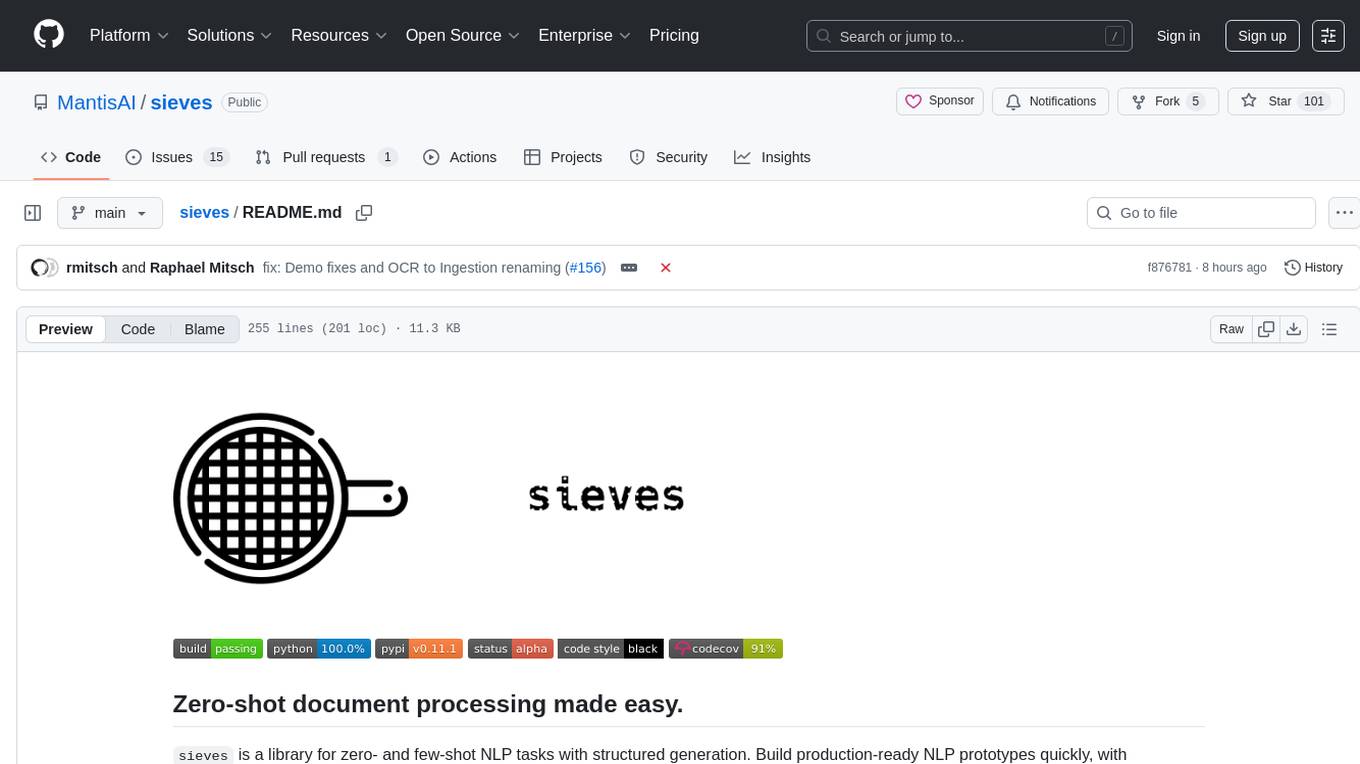
sieves is a library for zero- and few-shot NLP tasks with structured generation, enabling rapid prototyping of NLP applications without the need for training. It simplifies NLP prototyping by bundling capabilities into a single library, providing zero- and few-shot model support, a unified interface for structured generation, built-in tasks for common NLP operations, easy extendability, document-based pipeline architecture, caching to prevent redundant model calls, and more. The tool draws inspiration from spaCy and spacy-llm, offering features like immediate inference, observable pipelines, integrated tools for document parsing and text chunking, ready-to-use tasks such as classification, summarization, translation, and more, persistence for saving and loading pipelines, distillation for specialized model creation, and caching to optimize performance.
README:
sieves is a library for zero- and few-shot NLP tasks with structured generation. Build production-ready NLP prototypes quickly, with guaranteed output formats and no training required.
Read our documentation here. An automatically generated version (courtesy of Devin via DeepWiki) is available here.
Install sieves with pip install sieves. If you want to install all optional dependencies right away, install with
pip install sieves[engines,distill]. You can also choose to install individual dependencies as you see fit.
[!WARNING]
sievesis in active development and currently in beta. Be advised that the API might change in between minor version updates.
Even in the era of generative AI, structured outputs and observability remain crucial.
Many real-world scenarios require rapid prototyping with minimal data. Generative language models excel here, but
producing clean, structured output can be challenging. Various tools address this need for structured/guided language
model output, including outlines, dspy,
ollama, and others. Each has different design patterns, pros and cons. sieves wraps these tools and provides
a unified interface for input, processing, and output.
Developing NLP prototypes often involves repetitive steps: parsing and chunking documents, exporting results for
model fine-tuning, and experimenting with different prompting techniques. All these needs are addressed by existing
libraries in the NLP ecosystem address (e.g. docling for file parsing, or datasets for transforming
data into a unified format for model training).
sieves simplifies NLP prototyping by bundling these capabilities into a single library, allowing you to quickly
build modern NLP applications. It provides:
- Zero- and few-shot model support for immediate inference
- A bundle of utilities addressing common requirements in NLP applications
- A unified interface for structured generation across multiple libraries
- Built-in tasks for common NLP operations
- Easy extendability
- A document-based pipeline architecture for easy observability and debugging
- Caching - pipelines cache processed documents to prevent costly redundant model calls
sieves draws a lot of inspiration from spaCy and particularly spacy-llm.
- 🎯 Zero Training Required: Immediate inference using zero-/few-shot models
- 🤖 Unified Generation Interface: Seamlessly use multiple libraries
▶️ Observable Pipelines: Easy debugging and monitoring- 🛠️ Integrated Tools:
- Document parsing:
docling,unstructured,marker - Text chunking:
chonkie
- Document parsing:
- 🏷️ Ready-to-Use Tasks:
- Multi-label classification
- Information extraction
- Summarization
- Translation
- Multi-question answering
- Aspect-based sentiment analysis
- PII (personally identifiable information) anonymization
- Named entity recognition
- Coming soon: entity linking, knowledge graph creation, ...
- 💾 Persistence: Save and load pipelines with configurations
- 🧑🏫 Distillation: Distill local, specialized models using your zero-shot model results automatically.
Export your results as HuggingFace
Datasetif you want to run your own training routine. - ♻️ Caching to avoid unnecessary model calls
Here's a simple classification example using outlines:
from sieves import Pipeline, tasks, Doc
import outlines
# 1. Define documents by text or URI.
docs = [Doc(text="Special relativity applies to all physical phenomena in the absence of gravity.")]
# 2. Choose a model (Outlines in this example).
model = outlines.models.transformers("HuggingFaceTB/SmolLM-135M-Instruct")
# 3. Create pipeline with tasks (verbose init).
pipe = Pipeline(
# Add classification task to pipeline.
tasks.Classification(labels=["science", "politics"], model=model)
)
# 4. Run pipe and output results.
for doc in pipe(docs):
print(doc.results)
# Tip: Pipelines can also be composed succinctly via chaining (+).
# For multi-step pipelines, you can write:
# pipe = tasks.Ingestion(export_format="markdown") + tasks.Chunking(chunker) + tasks.Classification(labels=[...], model=model)
# Note: additional Pipeline parameters (e.g., use_cache=False) are only available via the verbose init,
# e.g., Pipeline([t1, t2], use_cache=False).Advanced Example
This example demonstrates PDF parsing, text chunking, and classification:
import pickle
import gliner.multitask
import chonkie
import tokenizers
import docling.document_converter
from sieves import Pipeline, tasks, Doc
# 1. Define documents by text or URI.
docs = [Doc(uri="https://arxiv.org/pdf/2408.09869")]
# 2. Choose a model for structured generation.
model_name = 'knowledgator/gliner-multitask-v1.0'
model = gliner.GLiNER.from_pretrained(model_name)
# 3. Create chunker object.
chunker = chonkie.TokenChunker(tokenizers.Tokenizer.from_pretrained(model_name))
# 3. Create pipeline with tasks.
pipe = Pipeline(
[
# 4. Add document parsing task.
tasks.Ingestion(export_format="markdown"),
# 5. Add chunking task to ensure we don't exceed our model's context window.
tasks.Chunking(chunker),
# 6. Add classification task to pipeline.
tasks.Classification(
task_id="classifier",
labels=["science", "politics"],
model=model,
),
]
)
# Alternatively you can also construct a pipeline by using the + operators:
# pipe = tasks.Ingestion(export_format="markdown") + tasks.Chunking(chunker) + tasks.Classification(
# task_id="classifier", labels=["science", "politics"], model=model
# )
# 7. Run pipe and output results.
docs = list(pipe(docs))
for doc in docs:
print(doc.results["classifier"])
# 8. Serialize pipeline and docs.
pipe.dump("pipeline.yml")
with open("docs.pkl", "wb") as f:
pickle.dump(docs, f)
# 9. Load pipeline and docs from disk. Note: we don't serialize complex third-party objects, so you'll have
# to pass those in at load time.
loaded_pipe = Pipeline.load(
"pipeline.yml",
(
{"converter": docling.document_converter.DocumentConverter(), "export_format": "markdown"},
{"chunker": chunker},
{"model": model},
),
)
with open("docs.pkl", "rb") as f:
loaded_docs = pickle.load(f)sieves is built on six key abstractions.
Orchestrates task execution with features for.
- Task configuration and sequencing
- Pipeline execution
- Configuration management and serialization
Represents a document in the pipeline.
- Contains text content and metadata
- Tracks document URI and processing results
- Passes information between pipeline tasks
Encapsulates a single processing step in a pipeline.
- Defines input arguments
- Wraps and initializes
Bridgeinstances handling task-engine-specific logic - Implements task-specific dataset export
Controls behavior of structured generation across tasks.
- Batch size
- Strict mode (whether errors in parsing individual documents should terminate execution)
- Arbitrary arguments passed on to structured generation tool (which one that is depends on the model you specified - Outlines, DSPy, LangChain, ...).
Provides a unified interface to structured generation libraries (internal). You pass a backend model into tasks;
Engine is used under the hood.
- Manages model interactions
- Handles prompt execution
- Standardizes output formats
Connects Task with Engine.
- Implements engine-specific prompt templates
- Manages output type specifications
- Ensures compatibility between tasks and engine
Show FAQs
sieves was originally motivated by the want to use generative models for structured information extraction. Coming
from this angle, there are two ways to explain why we settled on this name (pick the one you like better):
- An analogy to gold panning: run your raw data through a sieve to obtain structured, refined "gold."
- An acronym - "sieves" can be read as "Structured Information Extraction and VErification System" (but that's a mouthful).
Asked differently: what are the benefits of using sieves over directly interacting with an LLM?
- Validated, structured data output - also for LLMs that don't offer structured outputs natively. Zero-/few-shot language models can be finicky without guardrails or parsing.
- A step-by-step pipeline, making it easier to debug and track each stage.
- The flexibility to switch between different models and ways to ensure structured and validated output.
Below are minimal examples for creating model objects for each supported structured‑generation tool. Pass these model objects directly to tasks, optionally with GenerationSettings.
-
DSPy
import os import dspy # Anthropic example (set ANTHROPIC_API_KEY in your environment) model = dspy.LM("claude-3-haiku-20240307", api_key=os.environ["ANTHROPIC_API_KEY"]) # Tip: For local via Ollama, configure api_base and blank api_key: # model = dspy.LM("smollm:135m-instruct-v0.2-q8_0", api_base="http://localhost:11434", api_key="")
-
GLiNER
import gliner model = gliner.GLiNER.from_pretrained("knowledgator/gliner-multitask-v1.0")
-
LangChain
from langchain.chat_models import init_chat_model import os model = init_chat_model( model="claude-3-haiku-20240307", api_key=os.environ["ANTHROPIC_API_KEY"], model_provider="anthropic", )
-
Instructor
import anthropic import instructor from sieves.engines.instructor_ import Model import os client = instructor.from_anthropic(anthropic.AsyncClient(api_key=os.environ["ANTHROPIC_API_KEY"])) model = Model(name="claude-3-haiku-20240307", client=client)
-
Hugging Face Transformers (zero‑shot classification)
from transformers import pipeline model = pipeline( "zero-shot-classification", model="MoritzLaurer/xtremedistil-l6-h256-zeroshot-v1.1-all-33", )
-
Ollama (local server)
from sieves.engines.ollama_ import Model # Ensure `ollama serve` is running and the model is pulled (e.g., `ollama run smollm:135m-instruct-v0.2-q8_0`). model = Model(host="http://localhost:11434", name="smollm:135m-instruct-v0.2-q8_0")
-
Outlines
import outlines from transformers import AutoModelForCausalLM, AutoTokenizer model_name = "HuggingFaceTB/SmolLM-135M-Instruct" # Outlines supports different backends, also remote ones. We use a local `transformers` model here. model = outlines.models.from_transformers( AutoModelForCausalLM.from_pretrained(model_name), AutoTokenizer.from_pretrained(model_name), )
Notes
- Provide provider API keys via environment variables (e.g.,
ANTHROPIC_API_KEY). - Some backends (e.g., DSPy) can be pointed to a local Ollama server via
api_base. - After you have a
model, use it in tasks like:tasks.predictive.Classification(labels=[...], model=model). - A bunch of useful utilities for pre- and post-processing you might need.
- An array of useful tasks you can right of the bat without having to roll your own.
- Look up the respective tool's documentation for more information.
Which library makes the most sense to you depends strongly on your use-case. outlines provides structured generation
abilities, but not the pipeline system, utilities and pre-built tasks that sieves has to offer (and of course not the
flexibility to switch between different structured generation libraries). Then again, maybe you don't need all that -
in which case we recommend using outlines (or any other structured generation libray) directly.
Similarly, maybe you already have an existing tech stack in your project that uses exclusively ollama, langchain, or
dspy? All of these libraries (and more) are supported by sieves - but they are not just structured generation
libraries, they come with a plethora of features that are out of scope for sieves. If your application deeply
integrates with a framework like LangChain or DSPy, it may be reasonable to stick to those libraries directly.
As many things in engineering, this is a trade-off. The way we see it: the less tightly coupled your existing
application is with a particular language model framework, the more mileage you'll get out of sieves. This means that
it's ideal for prototyping (there's no reason you can't use it in production too, of course).
Source for
sievesicon: Sieve icons created by Freepik - Flaticon.
For Tasks:
Click tags to check more tools for each tasksFor Jobs:
Alternative AI tools for sieves
Similar Open Source Tools

sieves
sieves is a library for zero- and few-shot NLP tasks with structured generation, enabling rapid prototyping of NLP applications without the need for training. It simplifies NLP prototyping by bundling capabilities into a single library, providing zero- and few-shot model support, a unified interface for structured generation, built-in tasks for common NLP operations, easy extendability, document-based pipeline architecture, caching to prevent redundant model calls, and more. The tool draws inspiration from spaCy and spacy-llm, offering features like immediate inference, observable pipelines, integrated tools for document parsing and text chunking, ready-to-use tasks such as classification, summarization, translation, and more, persistence for saving and loading pipelines, distillation for specialized model creation, and caching to optimize performance.

shellChatGPT
ShellChatGPT is a shell wrapper for OpenAI's ChatGPT, DALL-E, Whisper, and TTS, featuring integration with LocalAI, Ollama, Gemini, Mistral, Groq, and GitHub Models. It provides text and chat completions, vision, reasoning, and audio models, voice-in and voice-out chatting mode, text editor interface, markdown rendering support, session management, instruction prompt manager, integration with various service providers, command line completion, file picker dialogs, color scheme personalization, stdin and text file input support, and compatibility with Linux, FreeBSD, MacOS, and Termux for a responsive experience.
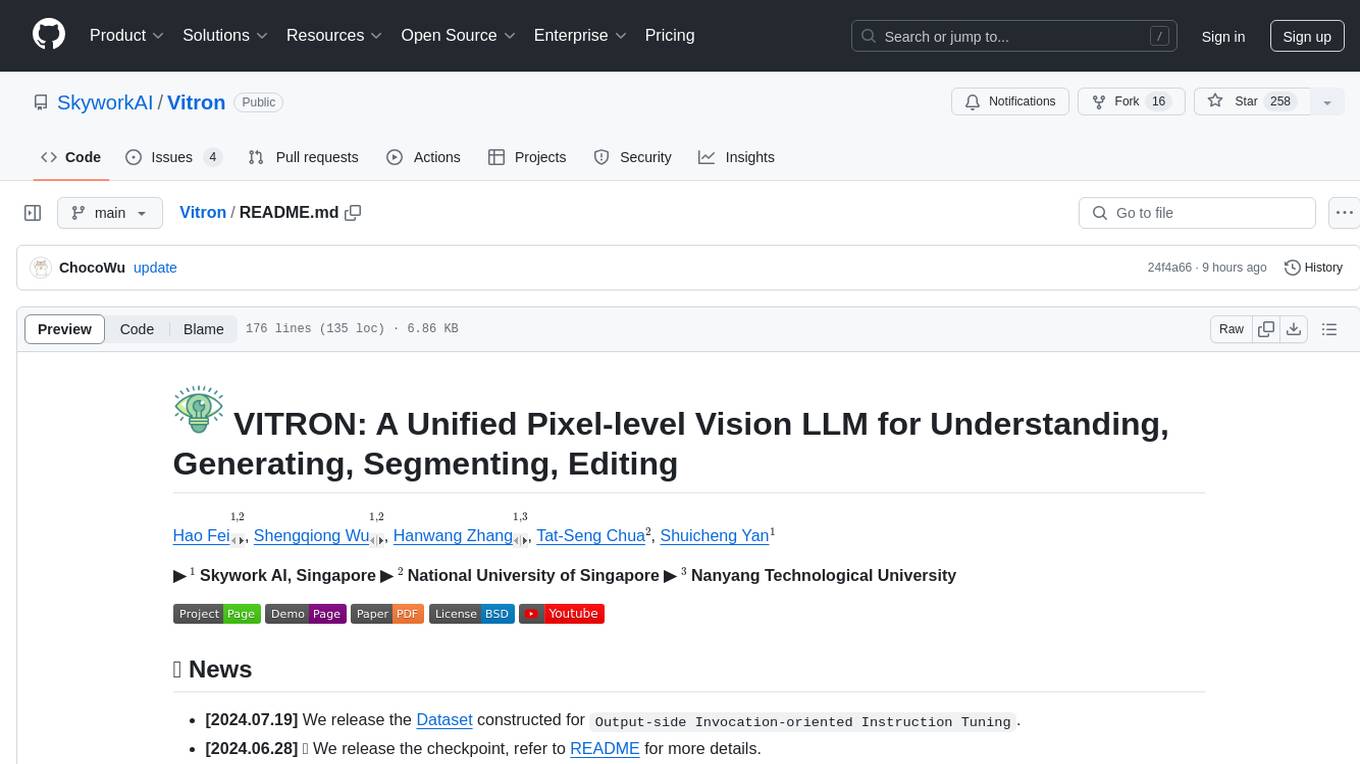
Vitron
Vitron is a unified pixel-level vision LLM designed for comprehensive understanding, generating, segmenting, and editing static images and dynamic videos. It addresses challenges in existing vision LLMs such as superficial instance-level understanding, lack of unified support for images and videos, and insufficient coverage across various vision tasks. The tool requires Python >= 3.8, Pytorch == 2.1.0, and CUDA Version >= 11.8 for installation. Users can deploy Gradio demo locally and fine-tune their models for specific tasks.
Pixel-Reasoner
Pixel Reasoner is a framework that introduces reasoning in the pixel-space for Vision-Language Models (VLMs), enabling them to directly inspect, interrogate, and infer from visual evidences. This enhances reasoning fidelity for visual tasks by equipping VLMs with visual reasoning operations like zoom-in and select-frame. The framework addresses challenges like model's imbalanced competence and reluctance to adopt pixel-space operations through a two-phase training approach involving instruction tuning and curiosity-driven reinforcement learning. With these visual operations, VLMs can interact with complex visual inputs such as images or videos to gather necessary information, leading to improved performance across visual reasoning benchmarks.
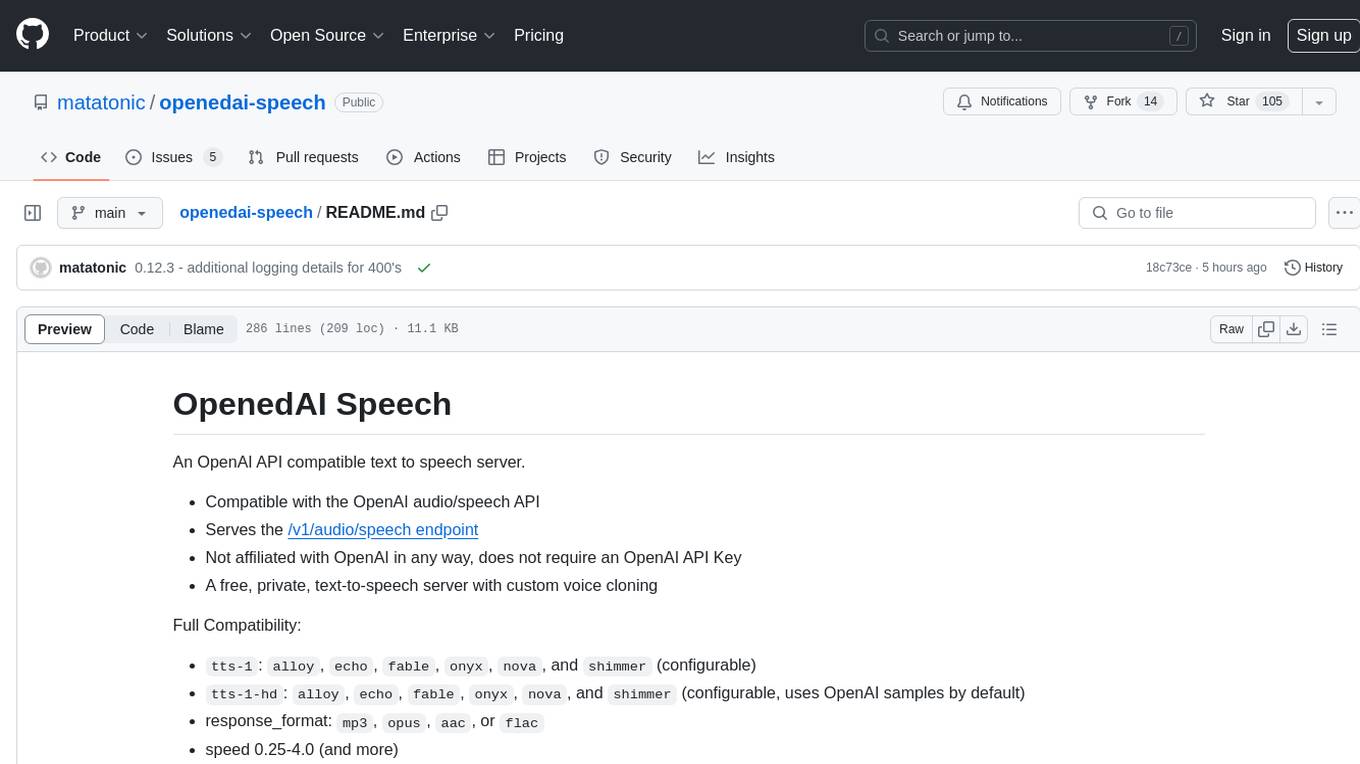
openedai-speech
OpenedAI Speech is a free, private text-to-speech server compatible with the OpenAI audio/speech API. It offers custom voice cloning and supports various models like tts-1 and tts-1-hd. Users can map their own piper voices and create custom cloned voices. The server provides multilingual support with XTTS voices and allows fixing incorrect sounds with regex. Recent changes include bug fixes, improved error handling, and updates for multilingual support. Installation can be done via Docker or manual setup, with usage instructions provided. Custom voices can be created using Piper or Coqui XTTS v2, with guidelines for preparing audio files. The tool is suitable for tasks like generating speech from text, creating custom voices, and multilingual text-to-speech applications.
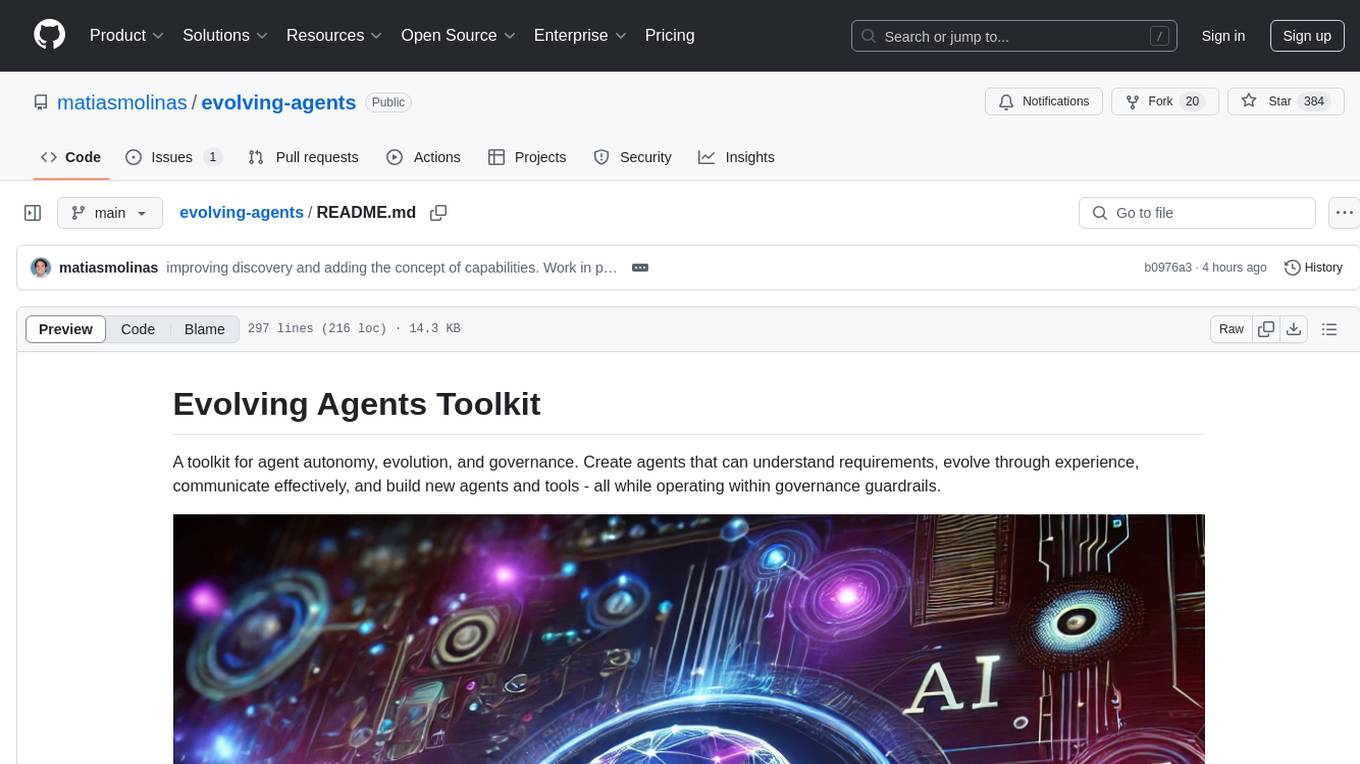
evolving-agents
A toolkit for agent autonomy, evolution, and governance enabling agents to learn from experience, collaborate, communicate, and build new tools within governance guardrails. It focuses on autonomous evolution, agent self-discovery, governance firmware, self-building systems, and agent-centric architecture. The toolkit leverages existing frameworks to enable agent autonomy and self-governance, moving towards truly autonomous AI systems.
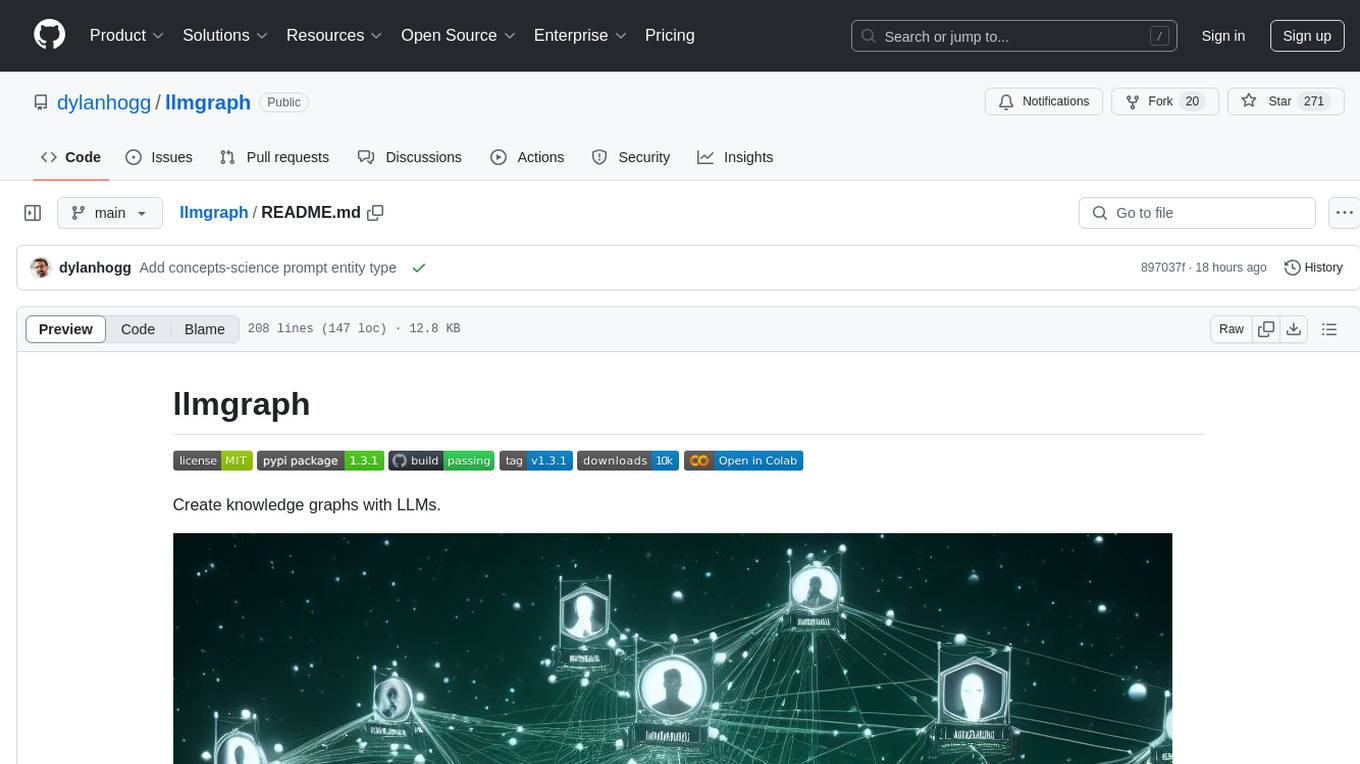
llmgraph
llmgraph is a tool that enables users to create knowledge graphs in GraphML, GEXF, and HTML formats by extracting world knowledge from large language models (LLMs) like ChatGPT. It supports various entity types and relationships, offers cache support for efficient graph growth, and provides insights into LLM costs. Users can customize the model used and interact with different LLM providers. The tool allows users to generate interactive graphs based on a specified entity type and Wikipedia link, making it a valuable resource for knowledge graph creation and exploration.
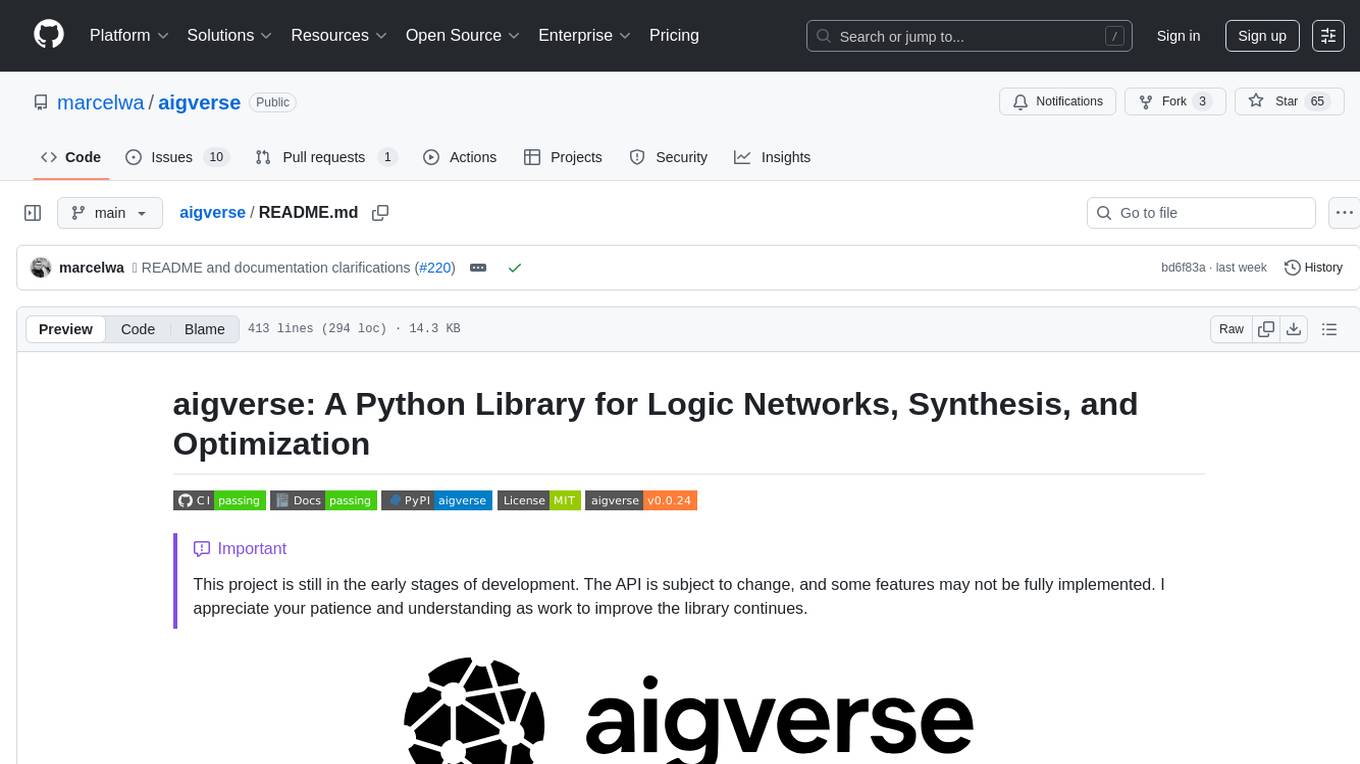
aigverse
aigverse is a Python infrastructure framework that bridges the gap between logic synthesis and AI/ML applications. It allows efficient representation and manipulation of logic circuits, making it easier to integrate logic synthesis and optimization tasks into machine learning pipelines. Built upon EPFL Logic Synthesis Libraries, particularly mockturtle, aigverse provides a high-level Python interface to state-of-the-art algorithms for And-Inverter Graph (AIG) manipulation and logic synthesis, widely used in formal verification, hardware design, and optimization tasks.
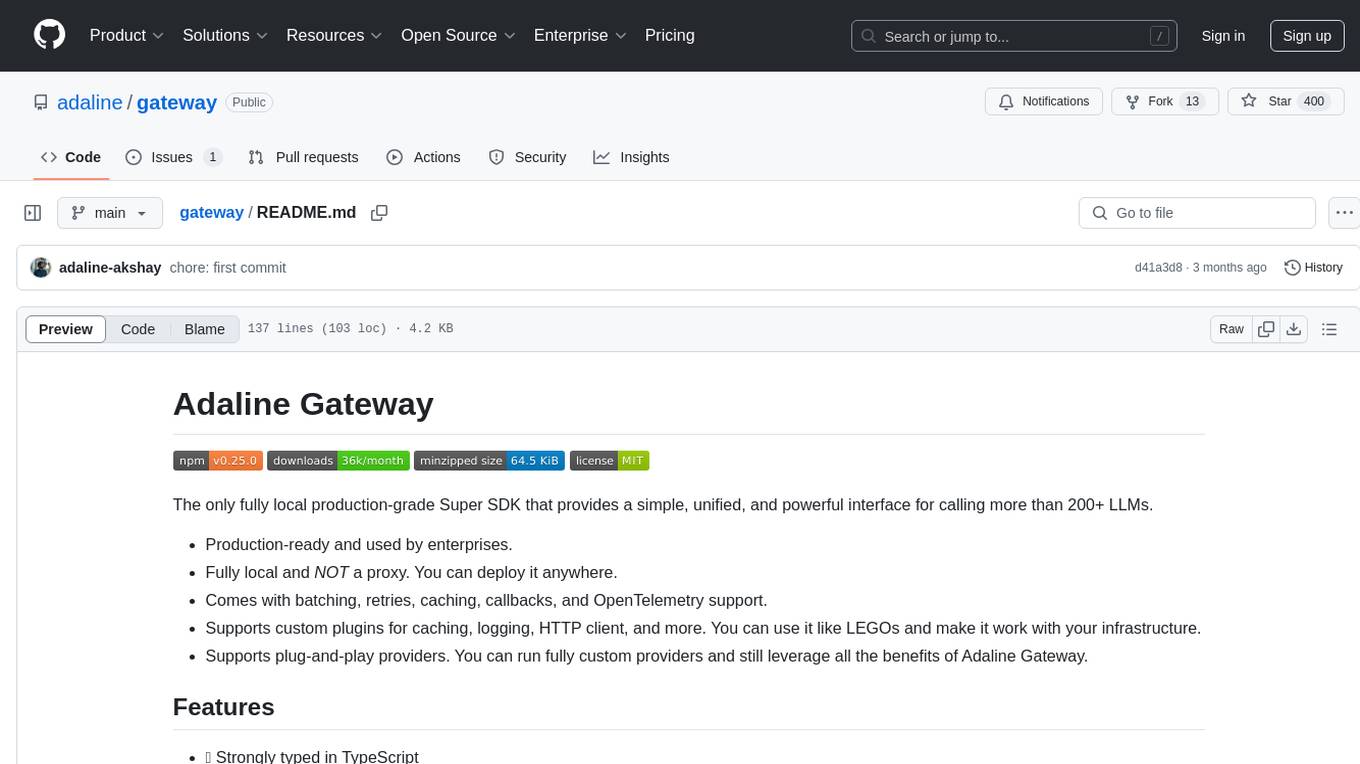
gateway
Adaline Gateway is a fully local production-grade Super SDK that offers a unified interface for calling over 200+ LLMs. It is production-ready, supports batching, retries, caching, callbacks, and OpenTelemetry. Users can create custom plugins and providers for seamless integration with their infrastructure.
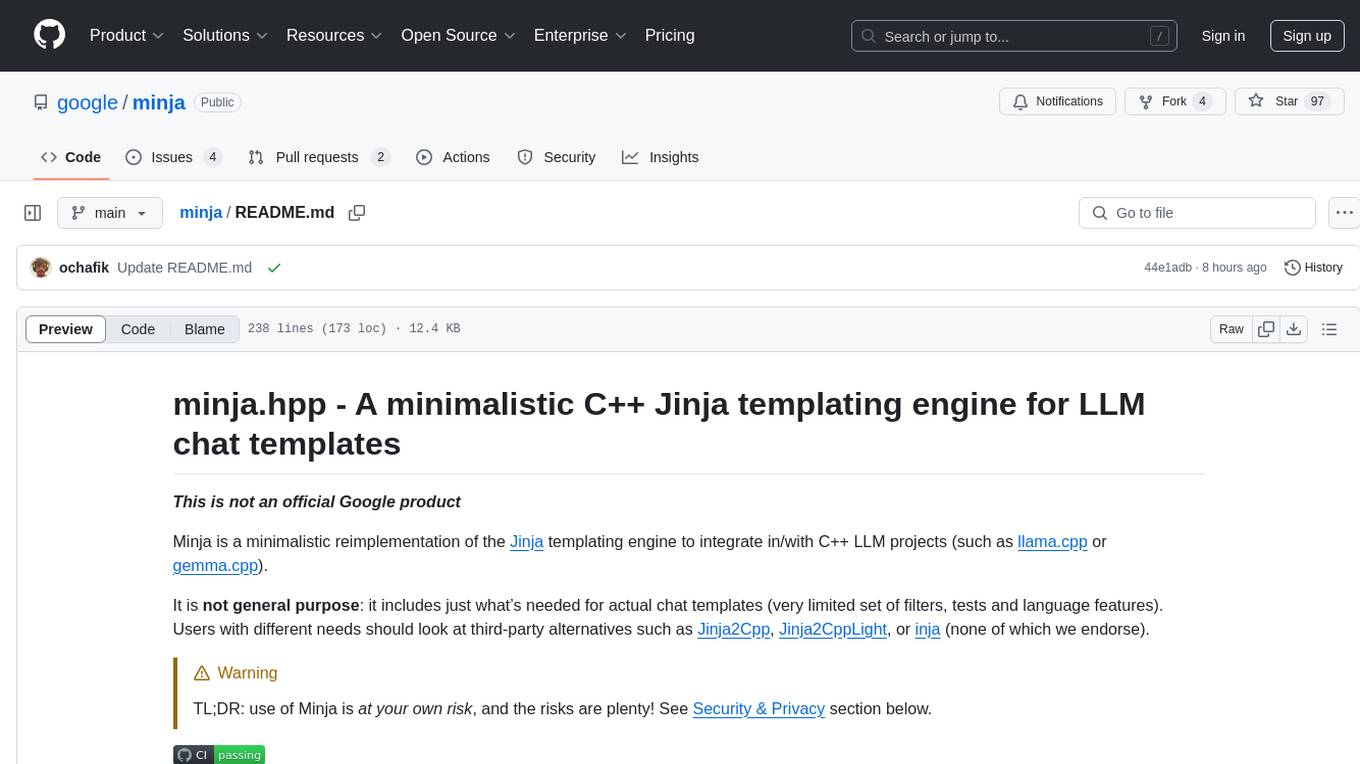
minja
Minja is a minimalistic C++ Jinja templating engine designed specifically for integration with C++ LLM projects, such as llama.cpp or gemma.cpp. It is not a general-purpose tool but focuses on providing a limited set of filters, tests, and language features tailored for chat templates. The library is header-only, requires C++17, and depends only on nlohmann::json. Minja aims to keep the codebase small, easy to understand, and offers decent performance compared to Python. Users should be cautious when using Minja due to potential security risks, and it is not intended for producing HTML or JavaScript output.
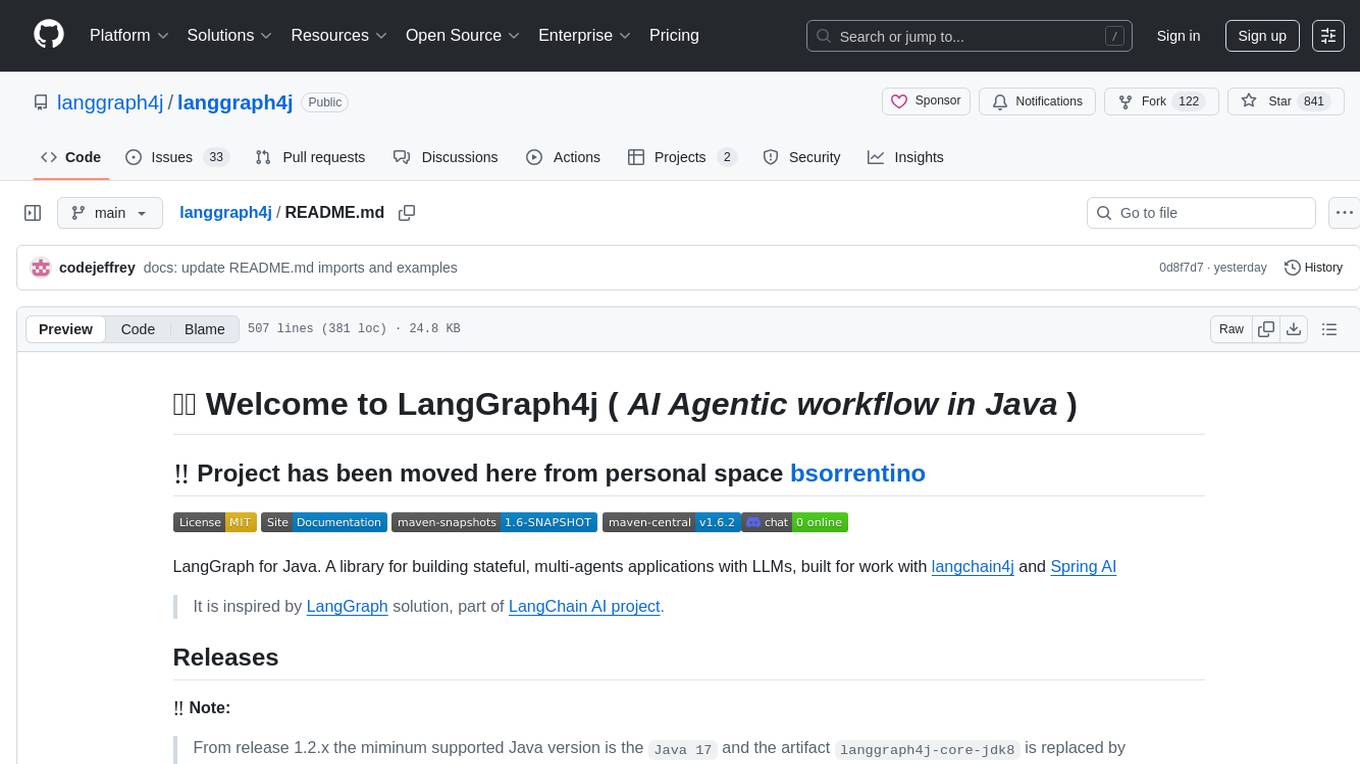
langgraph4j
Langgraph4j is a Java library for language processing tasks such as text classification, sentiment analysis, and named entity recognition. It provides a set of tools and algorithms for analyzing text data and extracting useful information. The library is designed to be efficient and easy to use, making it suitable for both research and production applications.
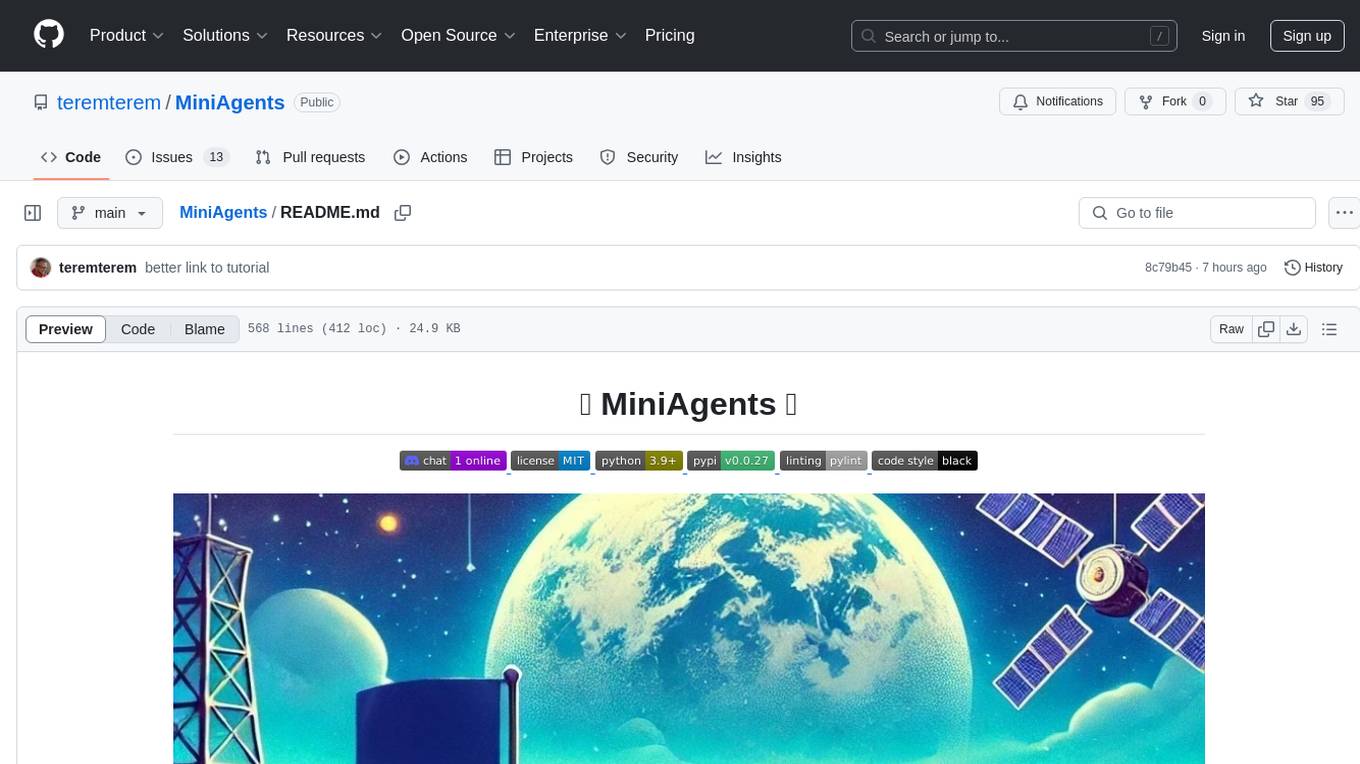
MiniAgents
MiniAgents is an open-source Python framework designed to simplify the creation of multi-agent AI systems. It offers a parallelism and async-first design, allowing users to focus on building intelligent agents while handling concurrency challenges. The framework, built on asyncio, supports LLM-based applications with immutable messages and seamless asynchronous token and message streaming between agents.
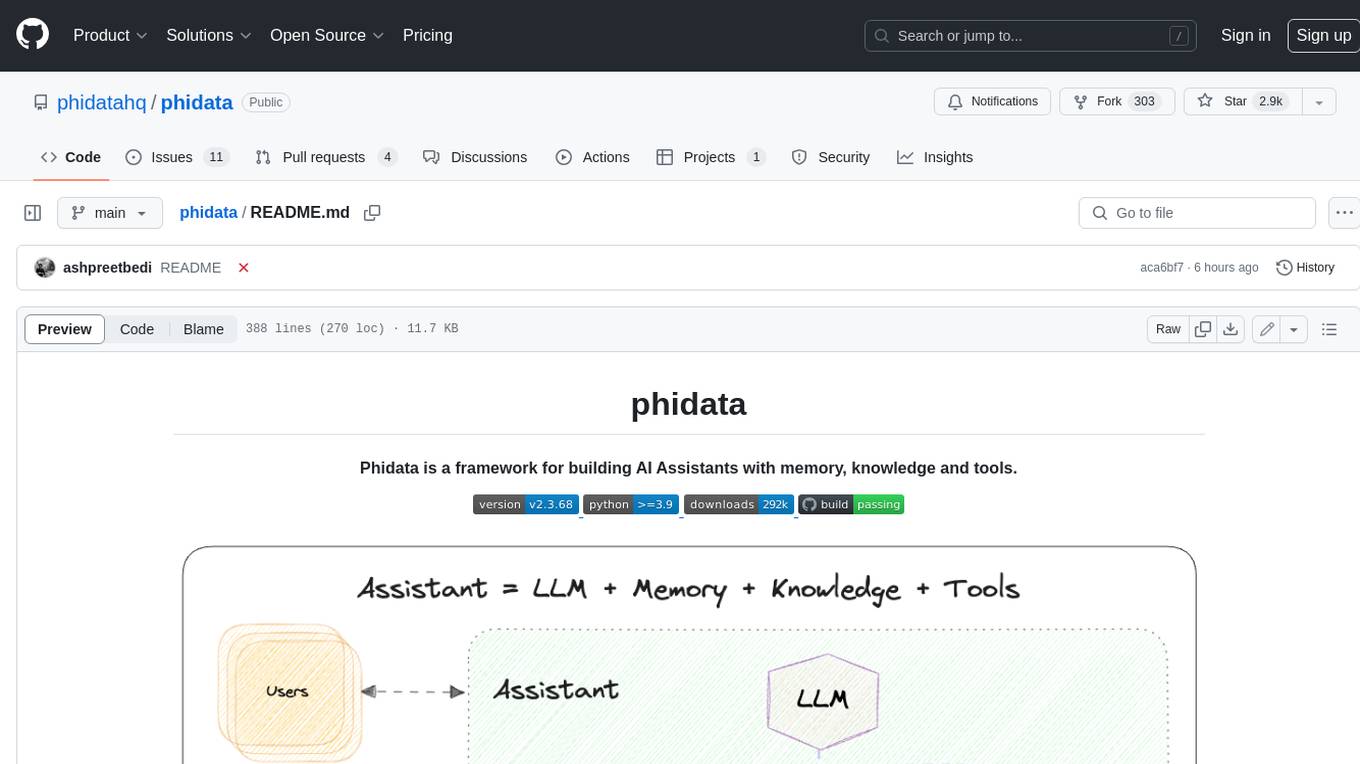
phidata
Phidata is a framework for building AI Assistants with memory, knowledge, and tools. It enables LLMs to have long-term conversations by storing chat history in a database, provides them with business context by storing information in a vector database, and enables them to take actions like pulling data from an API, sending emails, or querying a database. Memory and knowledge make LLMs smarter, while tools make them autonomous.
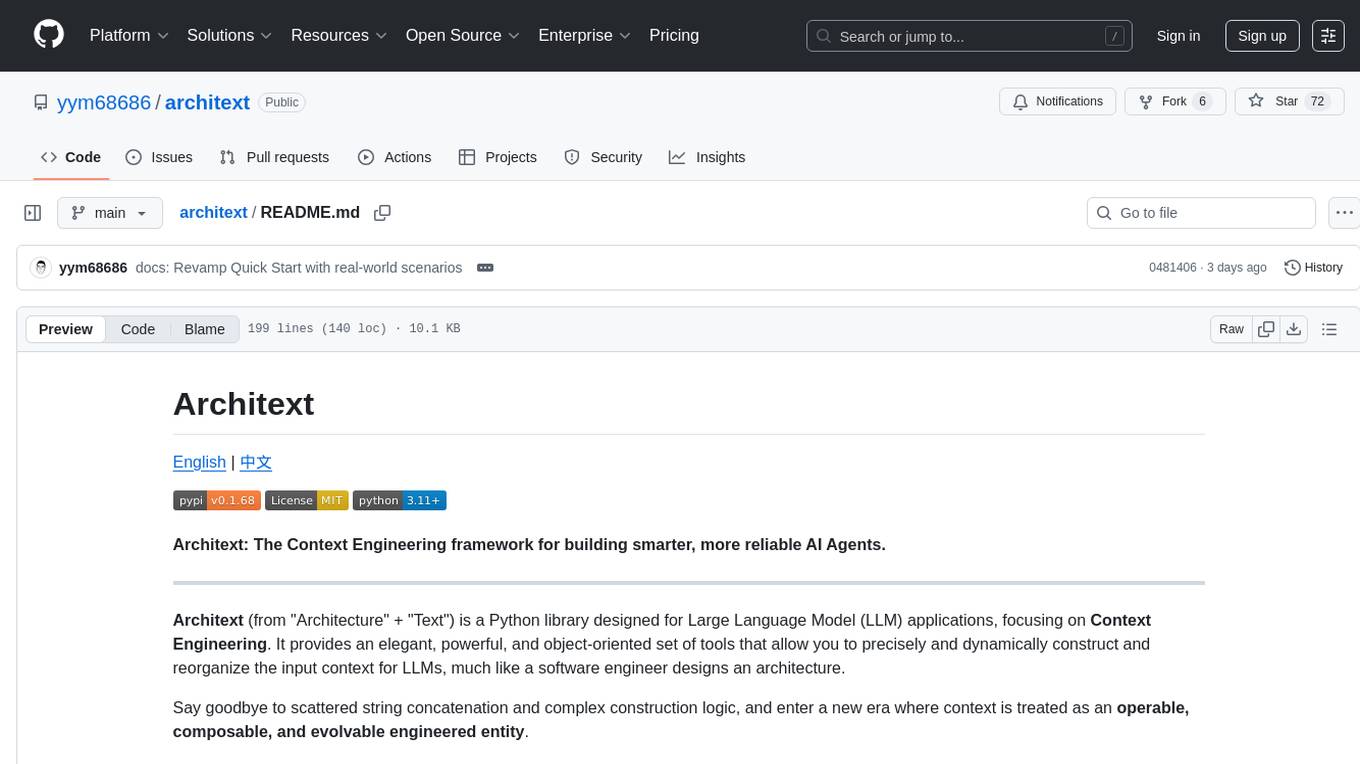
architext
Architext is a Python library designed for Large Language Model (LLM) applications, focusing on Context Engineering. It provides tools to construct and reorganize input context for LLMs dynamically. The library aims to elevate context construction from ad-hoc to systematic engineering, enabling precise manipulation of context content for AI Agents.
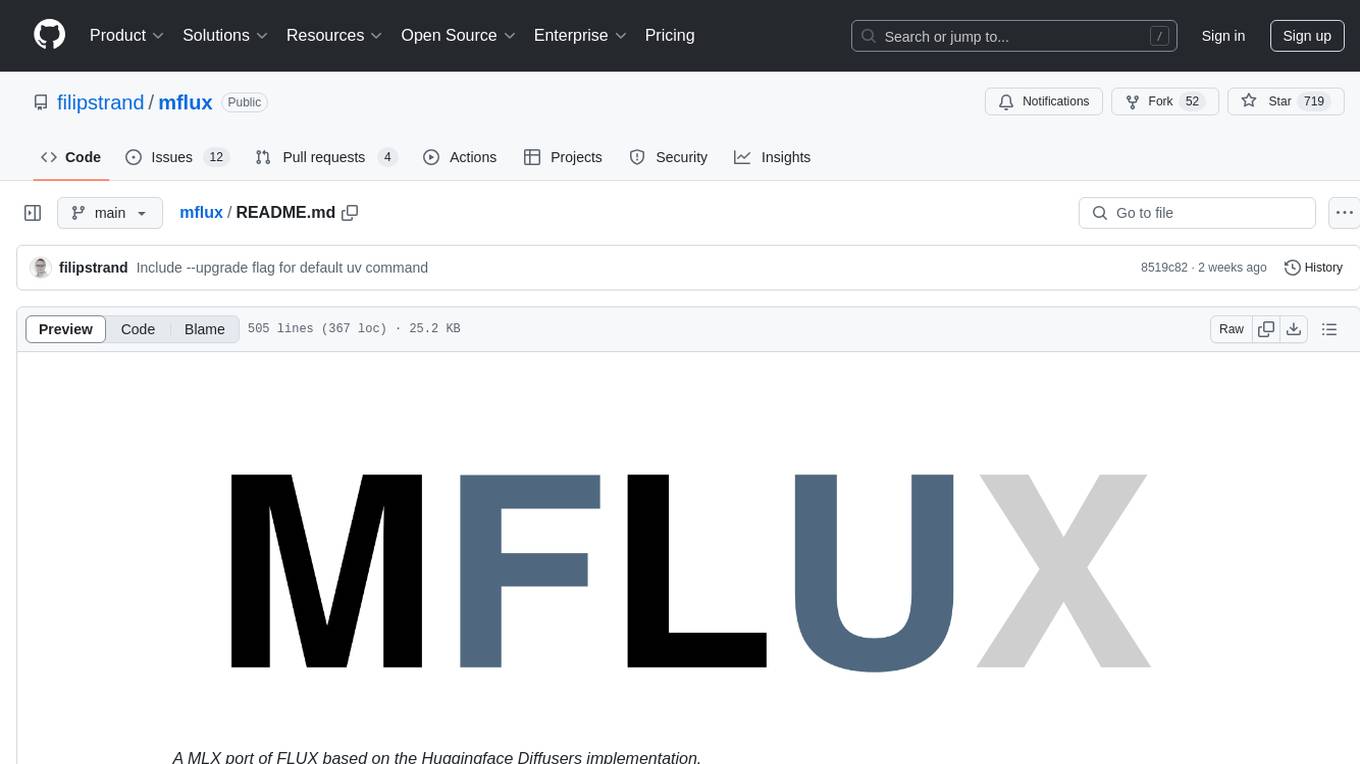
mflux
MFLUX is a line-by-line port of the FLUX implementation in the Huggingface Diffusers library to Apple MLX. It aims to run powerful FLUX models from Black Forest Labs locally on Mac machines. The codebase is minimal and explicit, prioritizing readability over generality and performance. Models are implemented from scratch in MLX, with tokenizers from the Huggingface Transformers library. Dependencies include Numpy and Pillow for image post-processing. Installation can be done using `uv tool` or classic virtual environment setup. Command-line arguments allow for image generation with specified models, prompts, and optional parameters. Quantization options for speed and memory reduction are available. LoRA adapters can be loaded for fine-tuning image generation. Controlnet support provides more control over image generation with reference images. Current limitations include generating images one by one, lack of support for negative prompts, and some LoRA adapters not working.
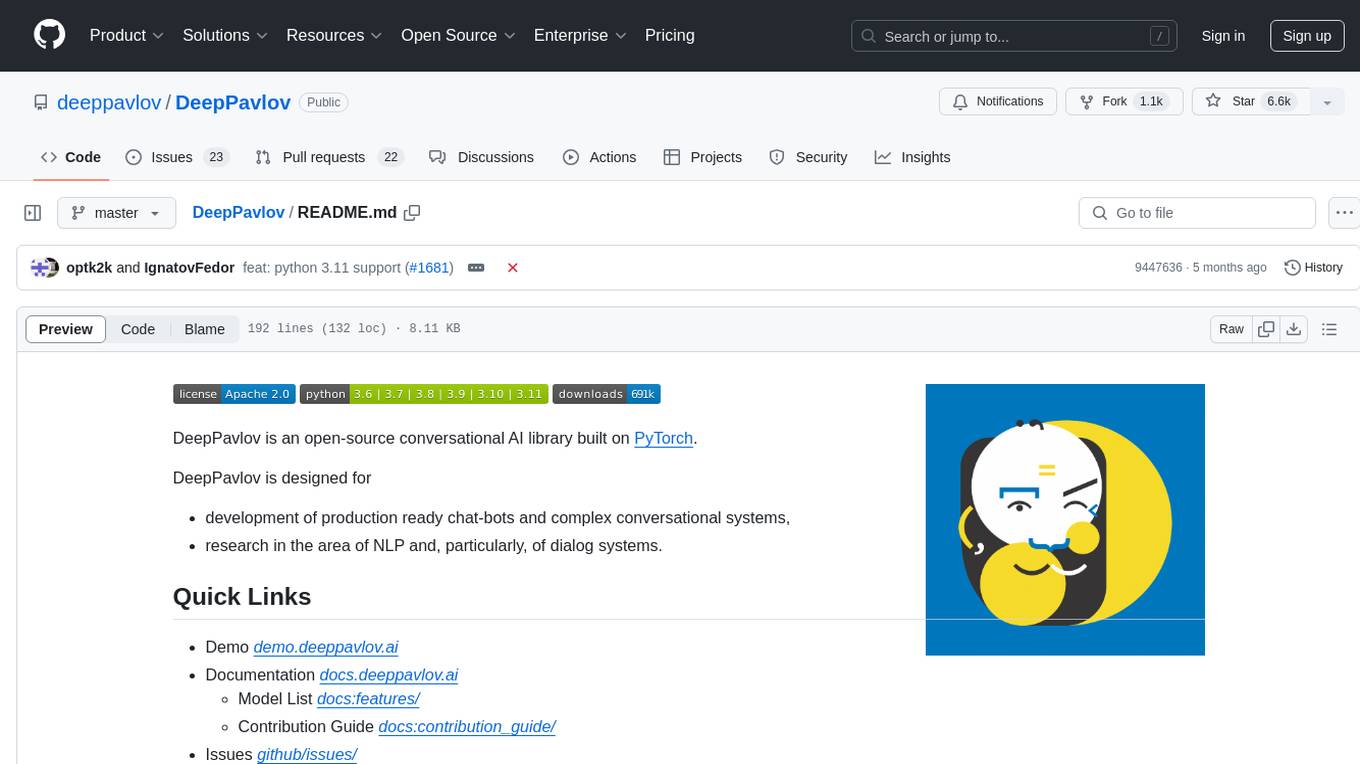
DeepPavlov
DeepPavlov is an open-source conversational AI library built on PyTorch. It is designed for the development of production-ready chatbots and complex conversational systems, as well as for research in the area of NLP and dialog systems. The library offers a wide range of models for tasks such as Named Entity Recognition, Intent/Sentence Classification, Question Answering, Sentence Similarity/Ranking, Syntactic Parsing, and more. DeepPavlov also provides embeddings like BERT, ELMo, and FastText for various languages, along with AutoML capabilities and integrations with REST API, Socket API, and Amazon AWS.
For similar tasks

sieves
sieves is a library for zero- and few-shot NLP tasks with structured generation, enabling rapid prototyping of NLP applications without the need for training. It simplifies NLP prototyping by bundling capabilities into a single library, providing zero- and few-shot model support, a unified interface for structured generation, built-in tasks for common NLP operations, easy extendability, document-based pipeline architecture, caching to prevent redundant model calls, and more. The tool draws inspiration from spaCy and spacy-llm, offering features like immediate inference, observable pipelines, integrated tools for document parsing and text chunking, ready-to-use tasks such as classification, summarization, translation, and more, persistence for saving and loading pipelines, distillation for specialized model creation, and caching to optimize performance.
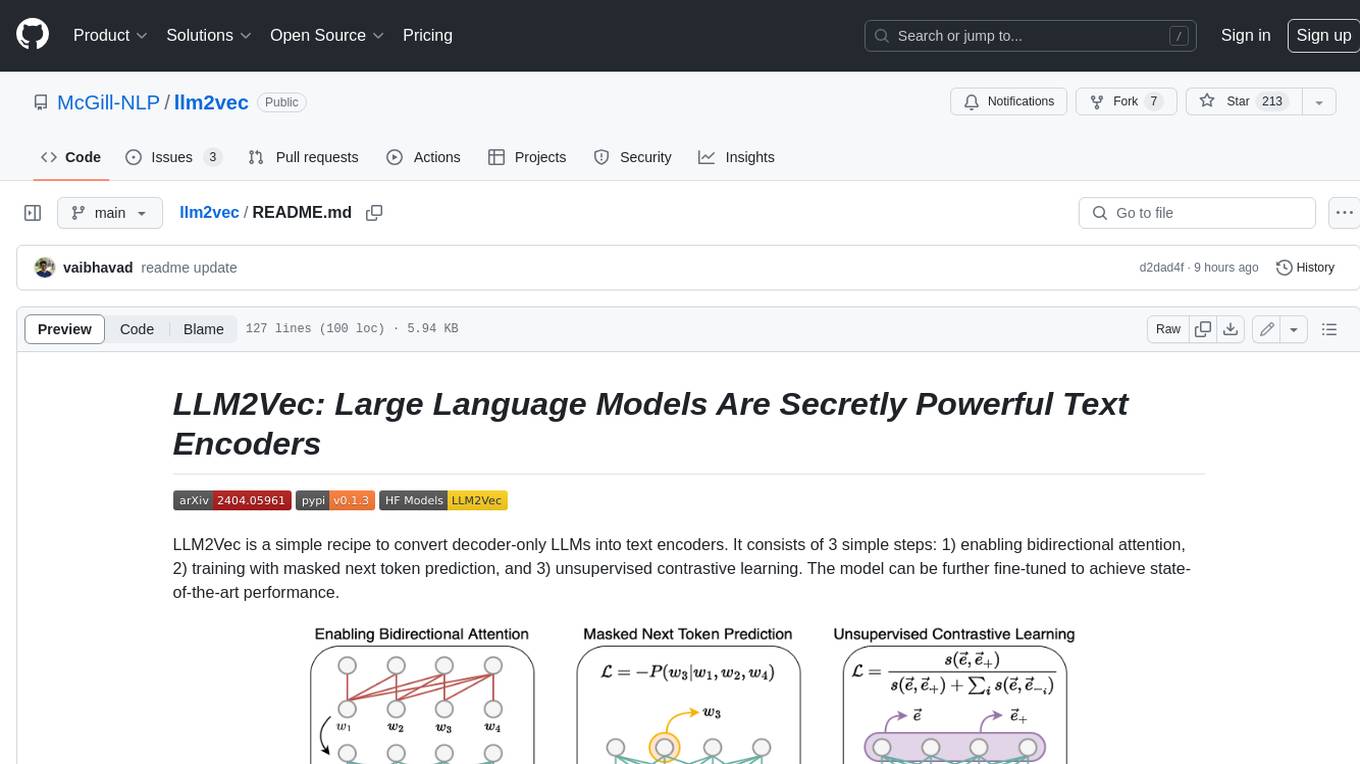
llm2vec
LLM2Vec is a simple recipe to convert decoder-only LLMs into text encoders. It consists of 3 simple steps: 1) enabling bidirectional attention, 2) training with masked next token prediction, and 3) unsupervised contrastive learning. The model can be further fine-tuned to achieve state-of-the-art performance.
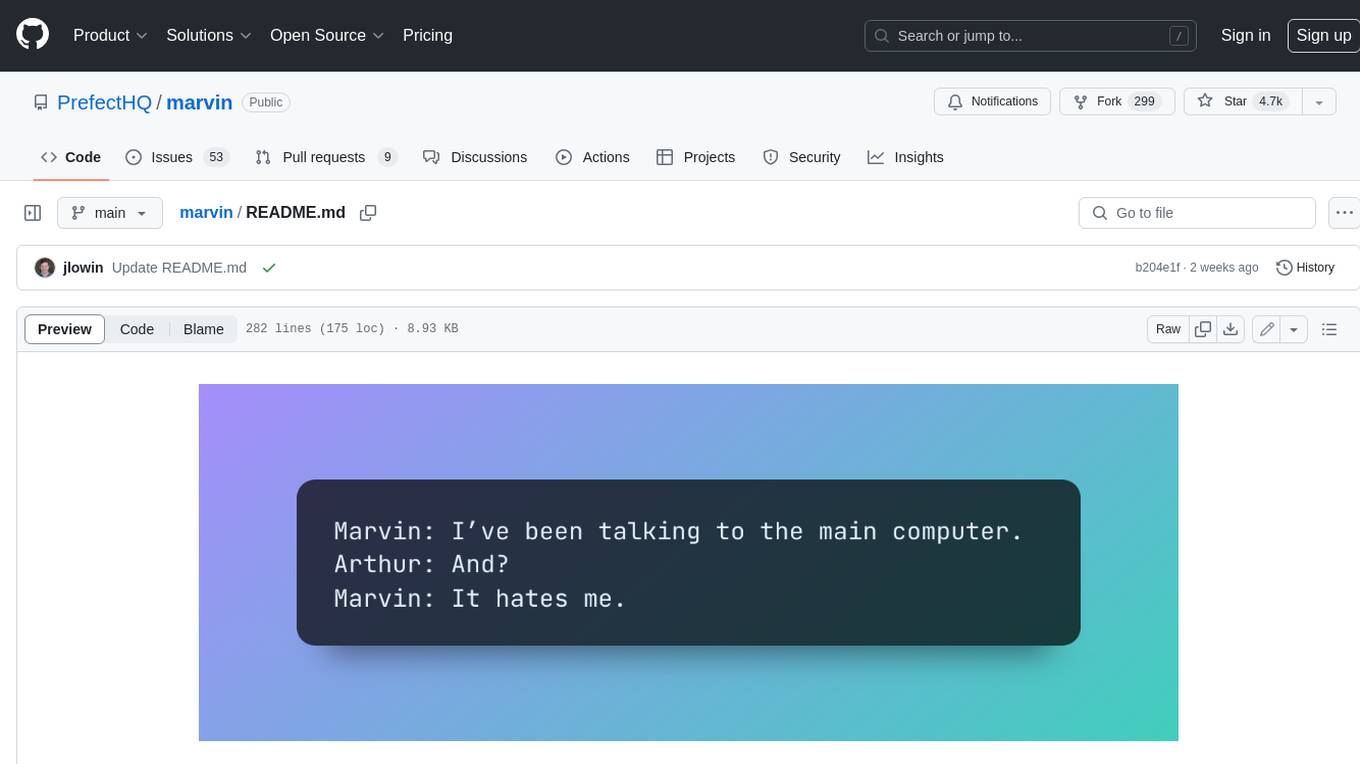
marvin
Marvin is a lightweight AI toolkit for building natural language interfaces that are reliable, scalable, and easy to trust. Each of Marvin's tools is simple and self-documenting, using AI to solve common but complex challenges like entity extraction, classification, and generating synthetic data. Each tool is independent and incrementally adoptable, so you can use them on their own or in combination with any other library. Marvin is also multi-modal, supporting both image and audio generation as well using images as inputs for extraction and classification. Marvin is for developers who care more about _using_ AI than _building_ AI, and we are focused on creating an exceptional developer experience. Marvin users should feel empowered to bring tightly-scoped "AI magic" into any traditional software project with just a few extra lines of code. Marvin aims to merge the best practices for building dependable, observable software with the best practices for building with generative AI into a single, easy-to-use library. It's a serious tool, but we hope you have fun with it. Marvin is open-source, free to use, and made with 💙 by the team at Prefect.
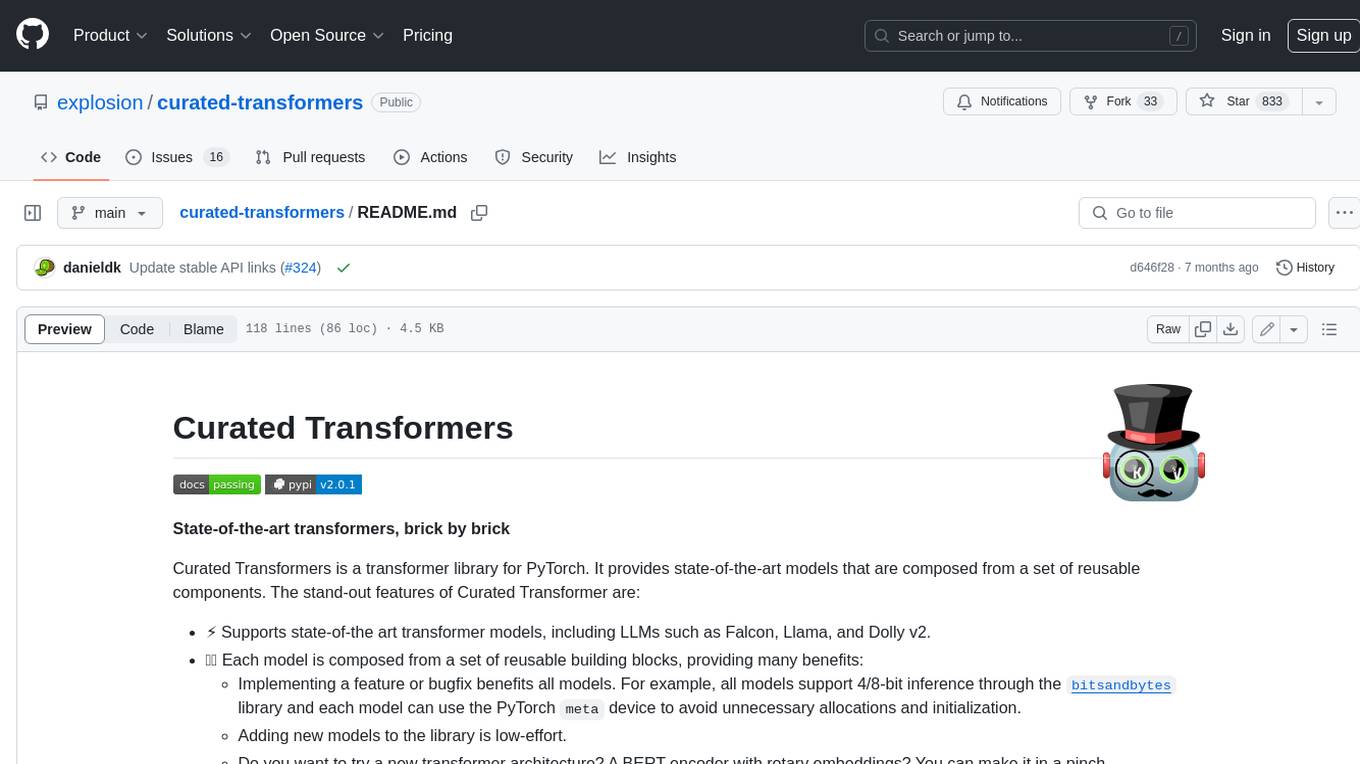
curated-transformers
Curated Transformers is a transformer library for PyTorch that provides state-of-the-art models composed of reusable components. It supports various transformer architectures, including encoders like ALBERT, BERT, and RoBERTa, and decoders like Falcon, Llama, and MPT. The library emphasizes consistent type annotations, minimal dependencies, and ease of use for education and research. It has been production-tested by Explosion and will be the default transformer implementation in spaCy 3.7.
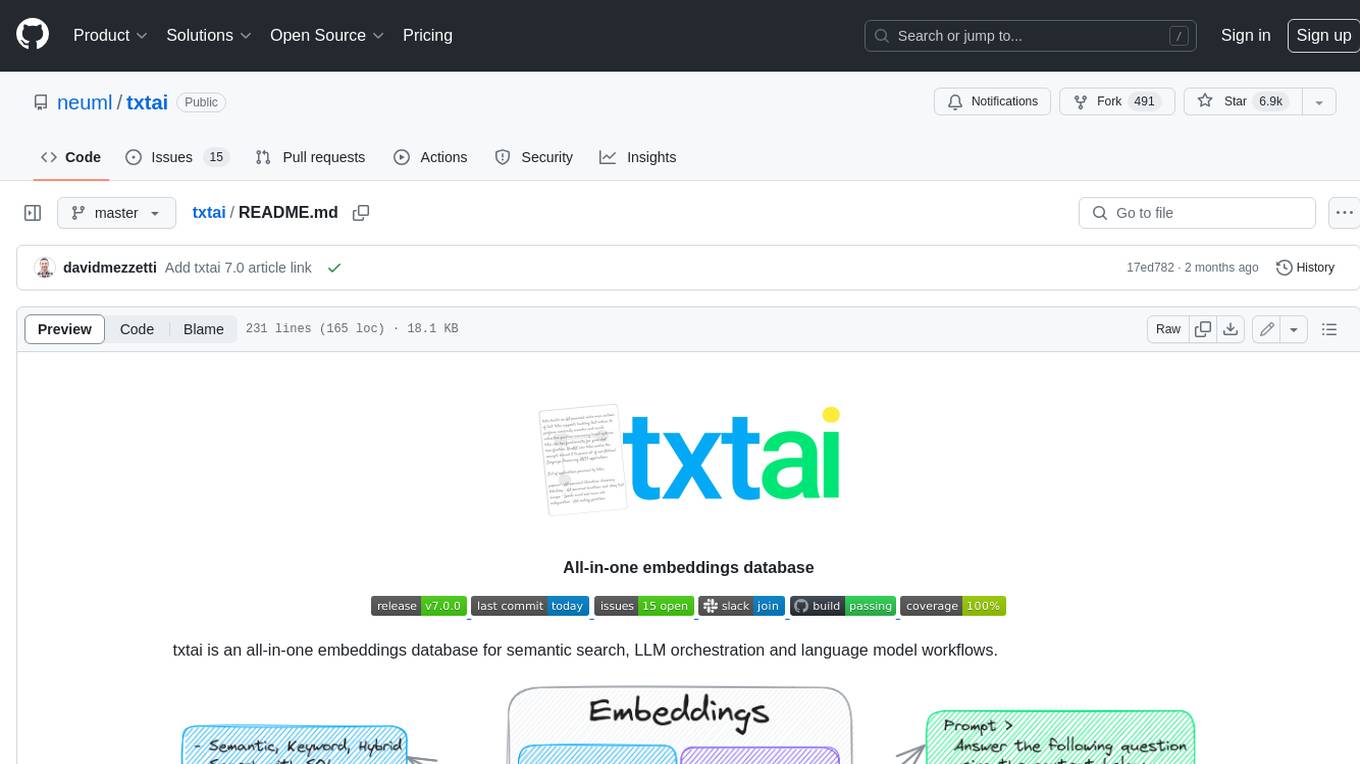
txtai
Txtai is an all-in-one embeddings database for semantic search, LLM orchestration, and language model workflows. It combines vector indexes, graph networks, and relational databases to enable vector search with SQL, topic modeling, retrieval augmented generation, and more. Txtai can stand alone or serve as a knowledge source for large language models (LLMs). Key features include vector search with SQL, object storage, topic modeling, graph analysis, multimodal indexing, embedding creation for various data types, pipelines powered by language models, workflows to connect pipelines, and support for Python, JavaScript, Java, Rust, and Go. Txtai is open-source under the Apache 2.0 license.
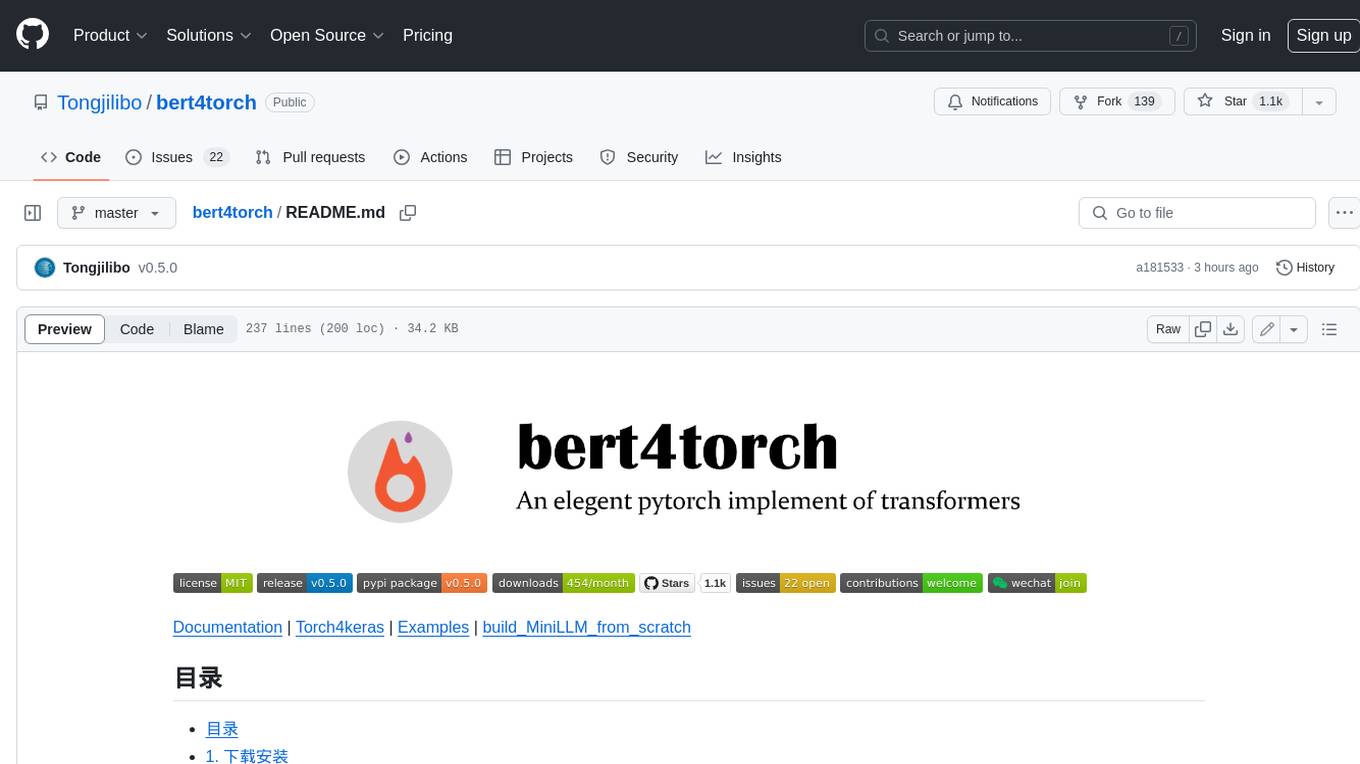
bert4torch
**bert4torch** is a high-level framework for training and deploying transformer models in PyTorch. It provides a simple and efficient API for building, training, and evaluating transformer models, and supports a wide range of pre-trained models, including BERT, RoBERTa, ALBERT, XLNet, and GPT-2. bert4torch also includes a number of useful features, such as data loading, tokenization, and model evaluation. It is a powerful and versatile tool for natural language processing tasks.
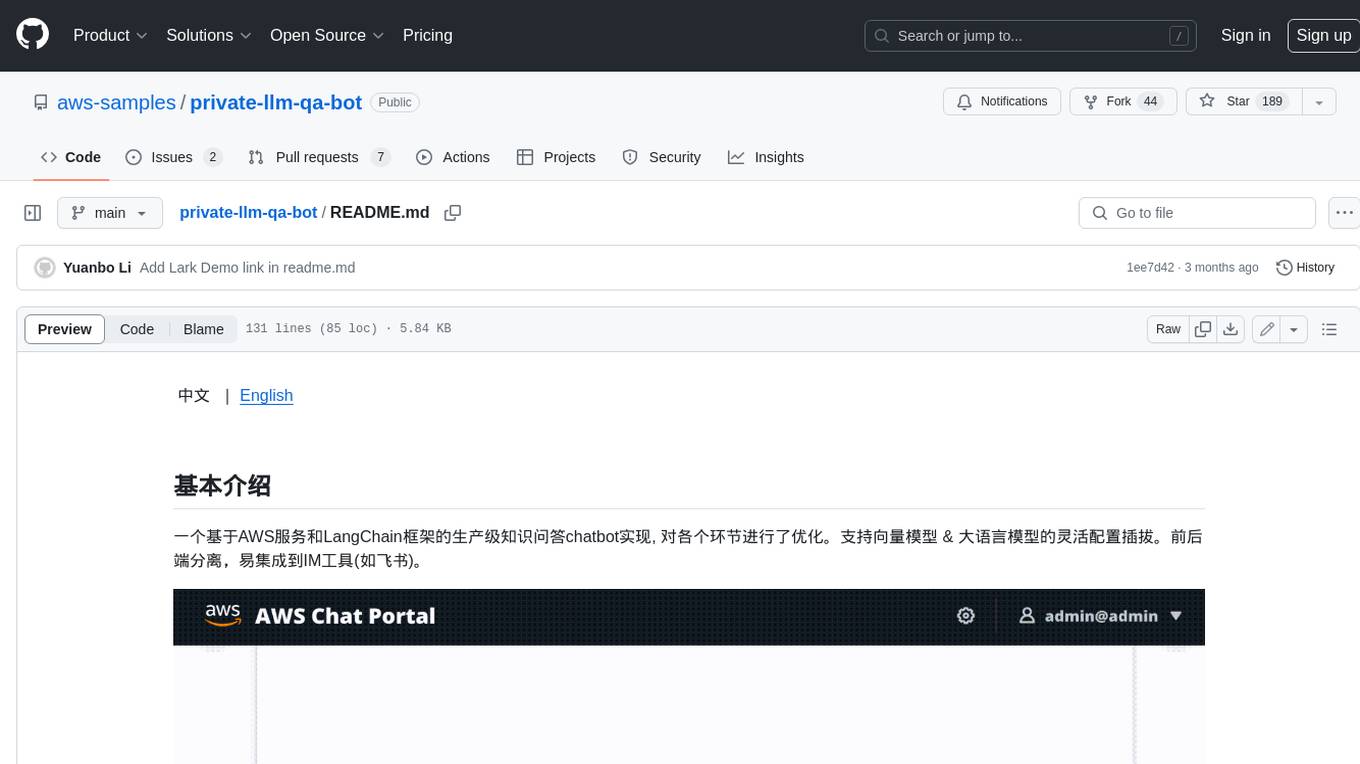
private-llm-qa-bot
This is a production-grade knowledge Q&A chatbot implementation based on AWS services and the LangChain framework, with optimizations at various stages. It supports flexible configuration and plugging of vector models and large language models. The front and back ends are separated, making it easy to integrate with IM tools (such as Feishu).
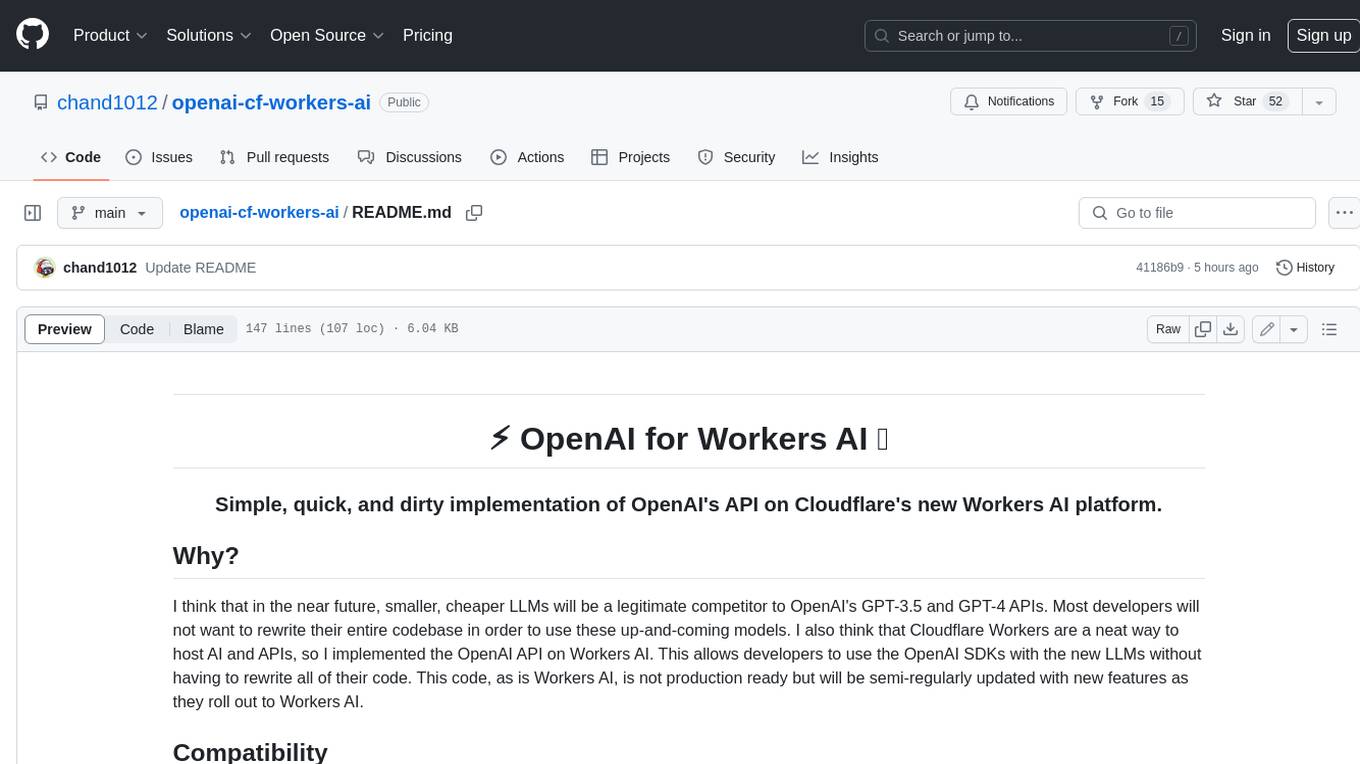
openai-cf-workers-ai
OpenAI for Workers AI is a simple, quick, and dirty implementation of OpenAI's API on Cloudflare's new Workers AI platform. It allows developers to use the OpenAI SDKs with the new LLMs without having to rewrite all of their code. The API currently supports completions, chat completions, audio transcription, embeddings, audio translation, and image generation. It is not production ready but will be semi-regularly updated with new features as they roll out to Workers AI.
For similar jobs
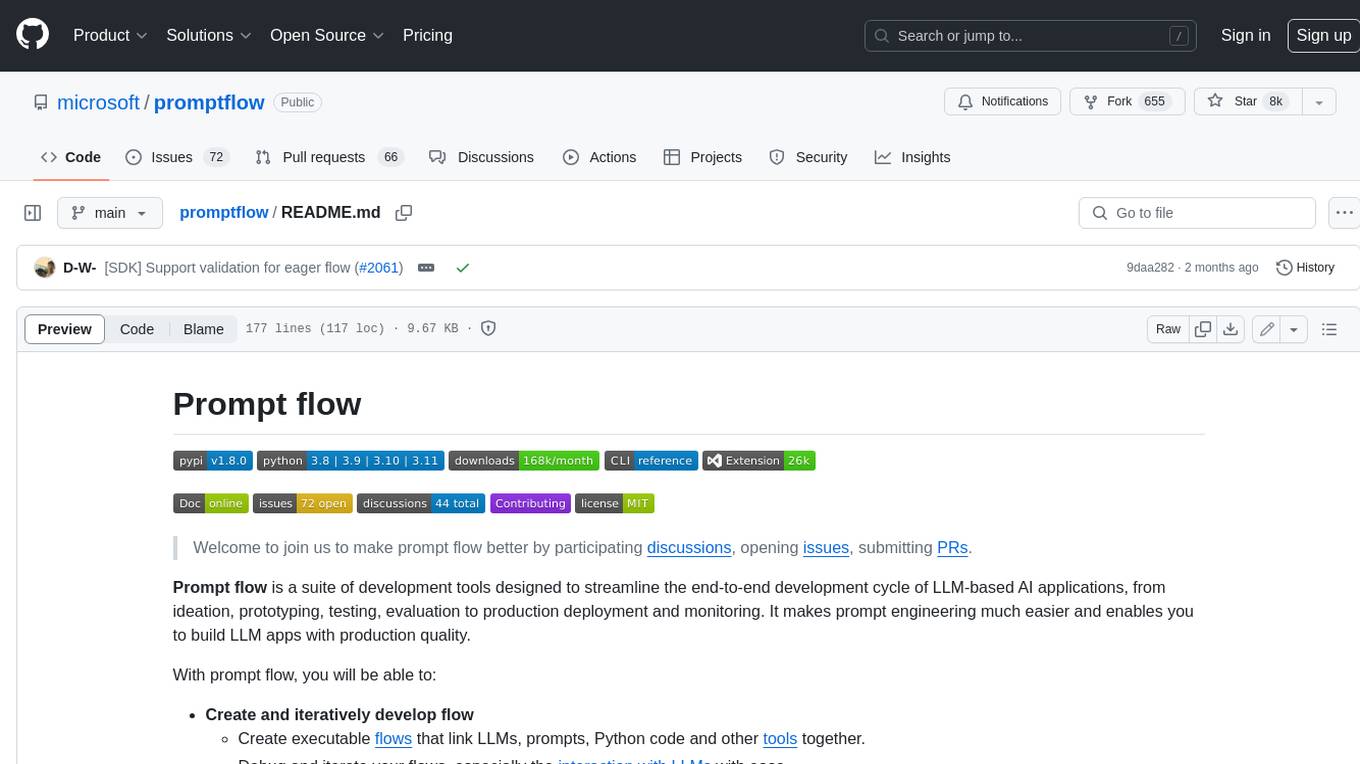
promptflow
**Prompt flow** is a suite of development tools designed to streamline the end-to-end development cycle of LLM-based AI applications, from ideation, prototyping, testing, evaluation to production deployment and monitoring. It makes prompt engineering much easier and enables you to build LLM apps with production quality.
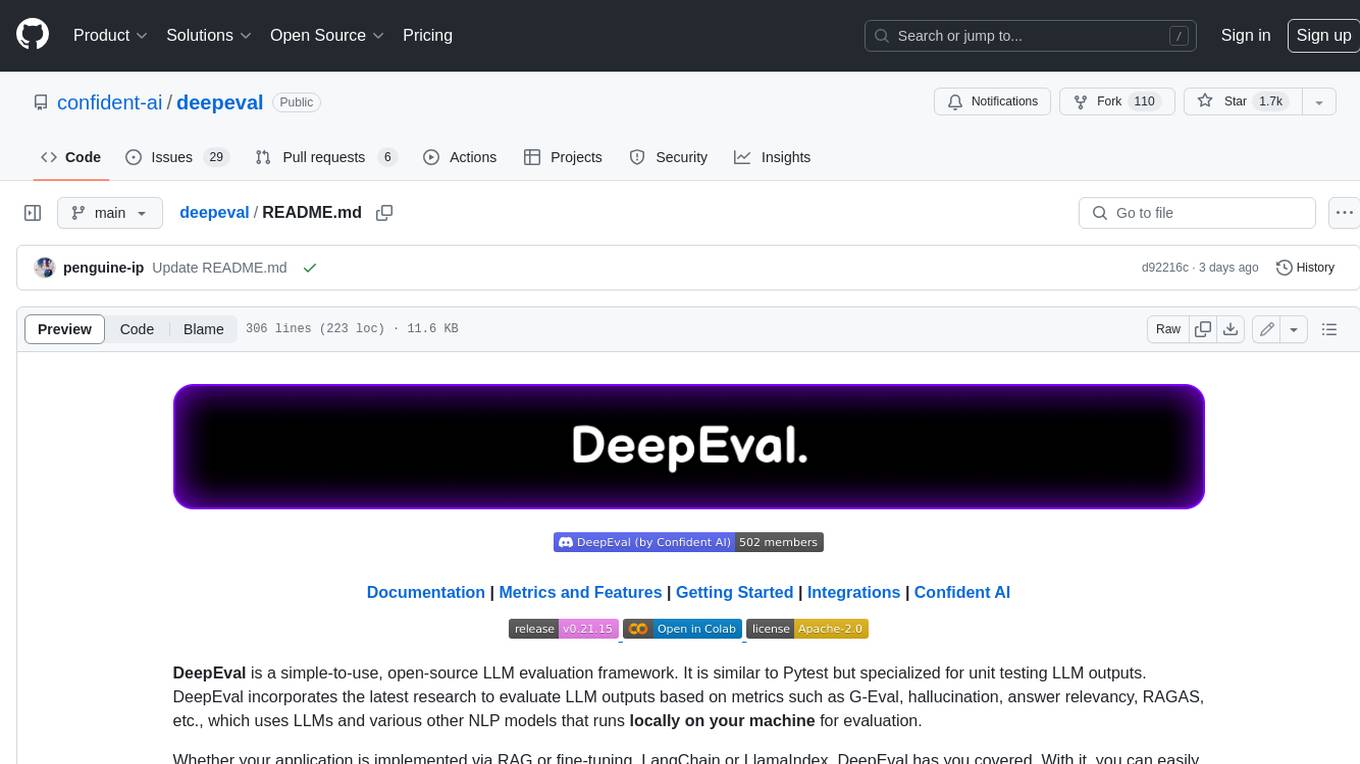
deepeval
DeepEval is a simple-to-use, open-source LLM evaluation framework specialized for unit testing LLM outputs. It incorporates various metrics such as G-Eval, hallucination, answer relevancy, RAGAS, etc., and runs locally on your machine for evaluation. It provides a wide range of ready-to-use evaluation metrics, allows for creating custom metrics, integrates with any CI/CD environment, and enables benchmarking LLMs on popular benchmarks. DeepEval is designed for evaluating RAG and fine-tuning applications, helping users optimize hyperparameters, prevent prompt drifting, and transition from OpenAI to hosting their own Llama2 with confidence.
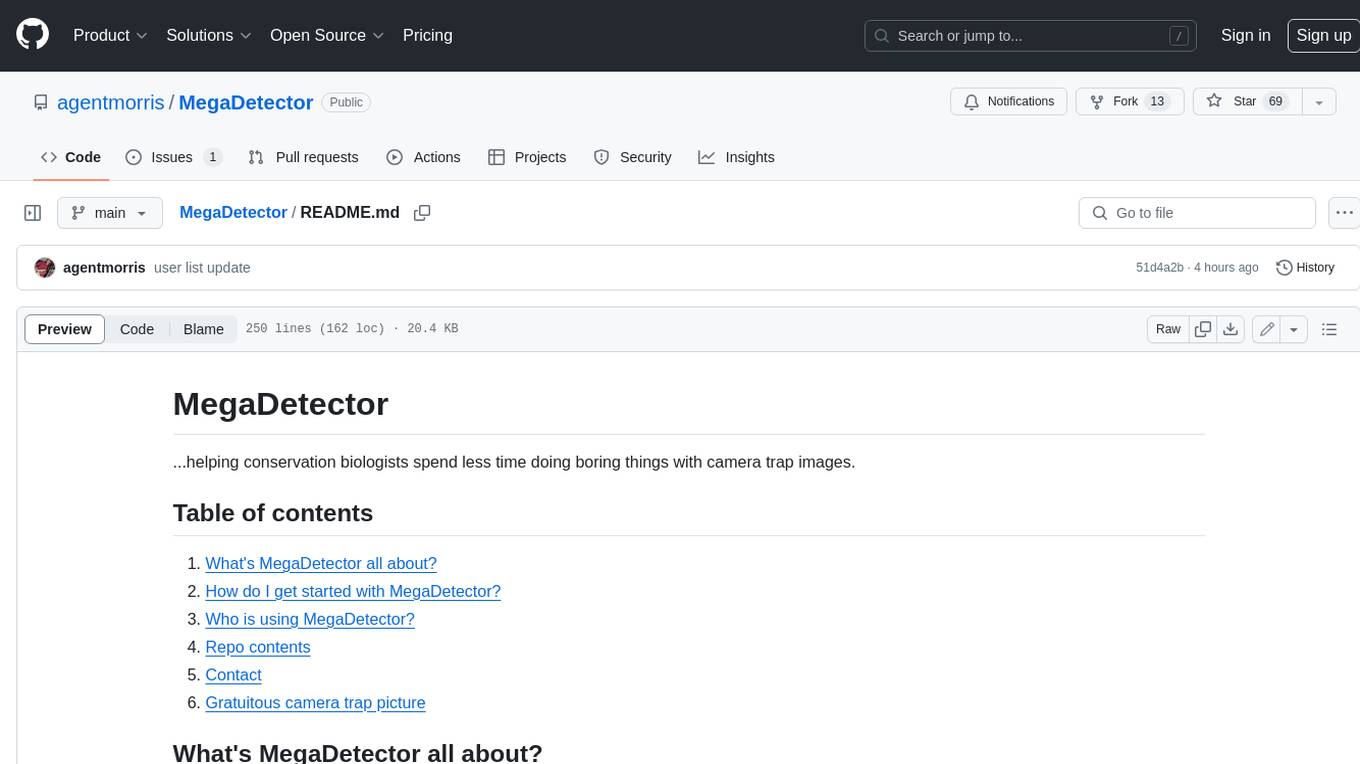
MegaDetector
MegaDetector is an AI model that identifies animals, people, and vehicles in camera trap images (which also makes it useful for eliminating blank images). This model is trained on several million images from a variety of ecosystems. MegaDetector is just one of many tools that aims to make conservation biologists more efficient with AI. If you want to learn about other ways to use AI to accelerate camera trap workflows, check out our of the field, affectionately titled "Everything I know about machine learning and camera traps".
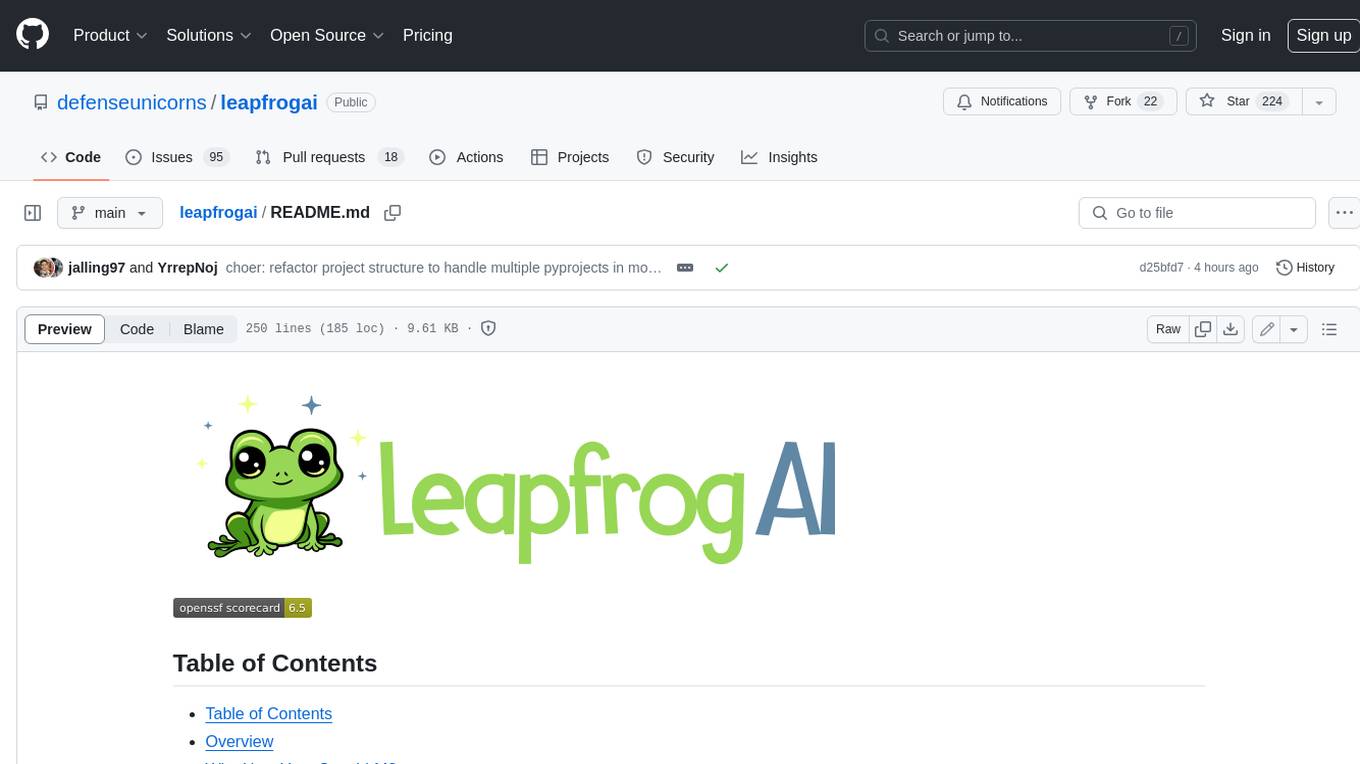
leapfrogai
LeapfrogAI is a self-hosted AI platform designed to be deployed in air-gapped resource-constrained environments. It brings sophisticated AI solutions to these environments by hosting all the necessary components of an AI stack, including vector databases, model backends, API, and UI. LeapfrogAI's API closely matches that of OpenAI, allowing tools built for OpenAI/ChatGPT to function seamlessly with a LeapfrogAI backend. It provides several backends for various use cases, including llama-cpp-python, whisper, text-embeddings, and vllm. LeapfrogAI leverages Chainguard's apko to harden base python images, ensuring the latest supported Python versions are used by the other components of the stack. The LeapfrogAI SDK provides a standard set of protobuffs and python utilities for implementing backends and gRPC. LeapfrogAI offers UI options for common use-cases like chat, summarization, and transcription. It can be deployed and run locally via UDS and Kubernetes, built out using Zarf packages. LeapfrogAI is supported by a community of users and contributors, including Defense Unicorns, Beast Code, Chainguard, Exovera, Hypergiant, Pulze, SOSi, United States Navy, United States Air Force, and United States Space Force.
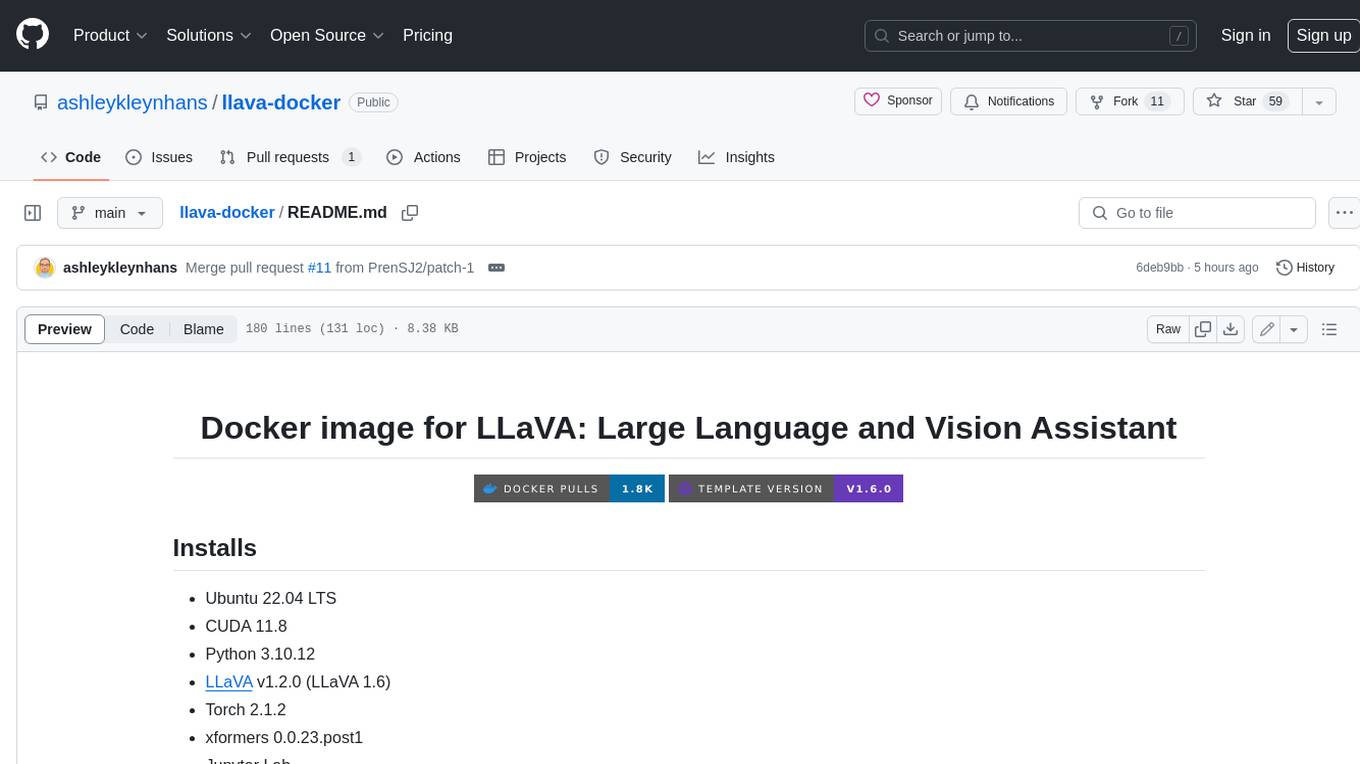
llava-docker
This Docker image for LLaVA (Large Language and Vision Assistant) provides a convenient way to run LLaVA locally or on RunPod. LLaVA is a powerful AI tool that combines natural language processing and computer vision capabilities. With this Docker image, you can easily access LLaVA's functionalities for various tasks, including image captioning, visual question answering, text summarization, and more. The image comes pre-installed with LLaVA v1.2.0, Torch 2.1.2, xformers 0.0.23.post1, and other necessary dependencies. You can customize the model used by setting the MODEL environment variable. The image also includes a Jupyter Lab environment for interactive development and exploration. Overall, this Docker image offers a comprehensive and user-friendly platform for leveraging LLaVA's capabilities.

carrot
The 'carrot' repository on GitHub provides a list of free and user-friendly ChatGPT mirror sites for easy access. The repository includes sponsored sites offering various GPT models and services. Users can find and share sites, report errors, and access stable and recommended sites for ChatGPT usage. The repository also includes a detailed list of ChatGPT sites, their features, and accessibility options, making it a valuable resource for ChatGPT users seeking free and unlimited GPT services.
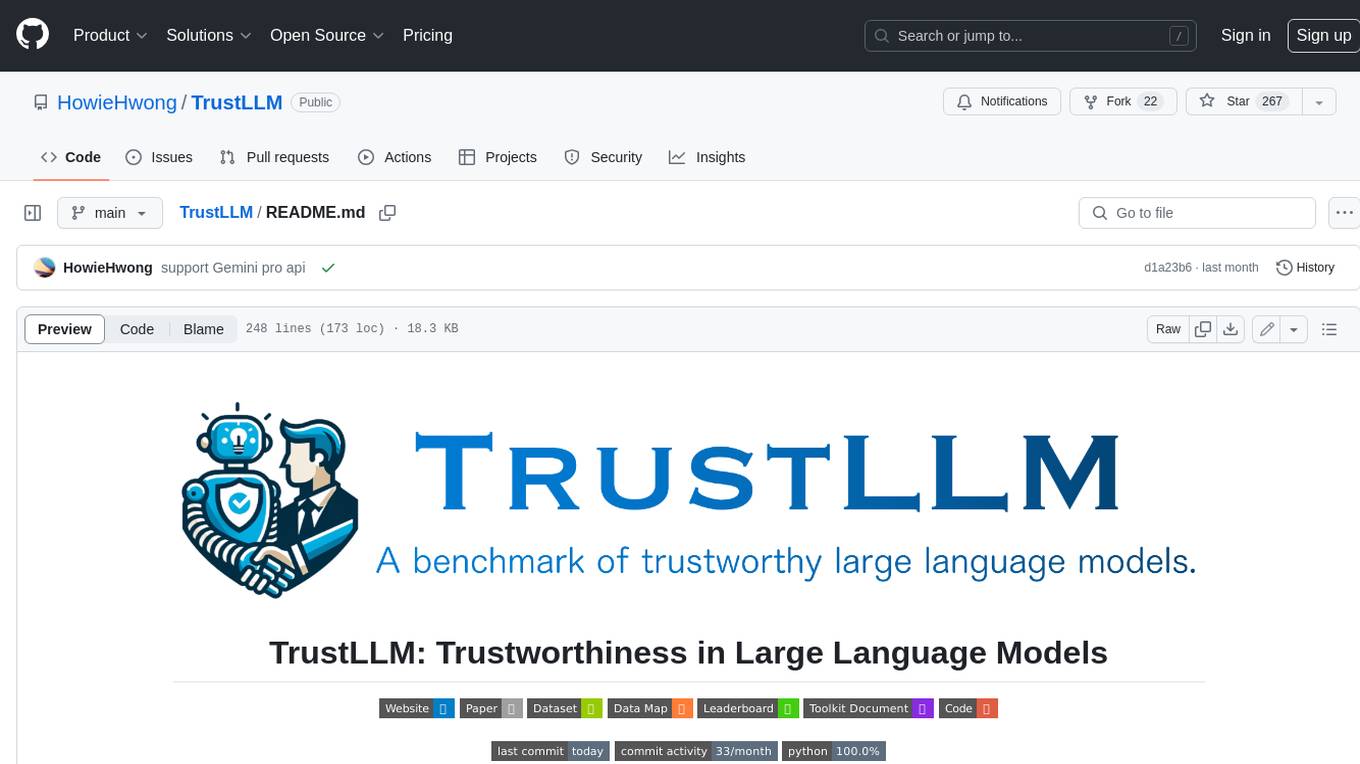
TrustLLM
TrustLLM is a comprehensive study of trustworthiness in LLMs, including principles for different dimensions of trustworthiness, established benchmark, evaluation, and analysis of trustworthiness for mainstream LLMs, and discussion of open challenges and future directions. Specifically, we first propose a set of principles for trustworthy LLMs that span eight different dimensions. Based on these principles, we further establish a benchmark across six dimensions including truthfulness, safety, fairness, robustness, privacy, and machine ethics. We then present a study evaluating 16 mainstream LLMs in TrustLLM, consisting of over 30 datasets. The document explains how to use the trustllm python package to help you assess the performance of your LLM in trustworthiness more quickly. For more details about TrustLLM, please refer to project website.
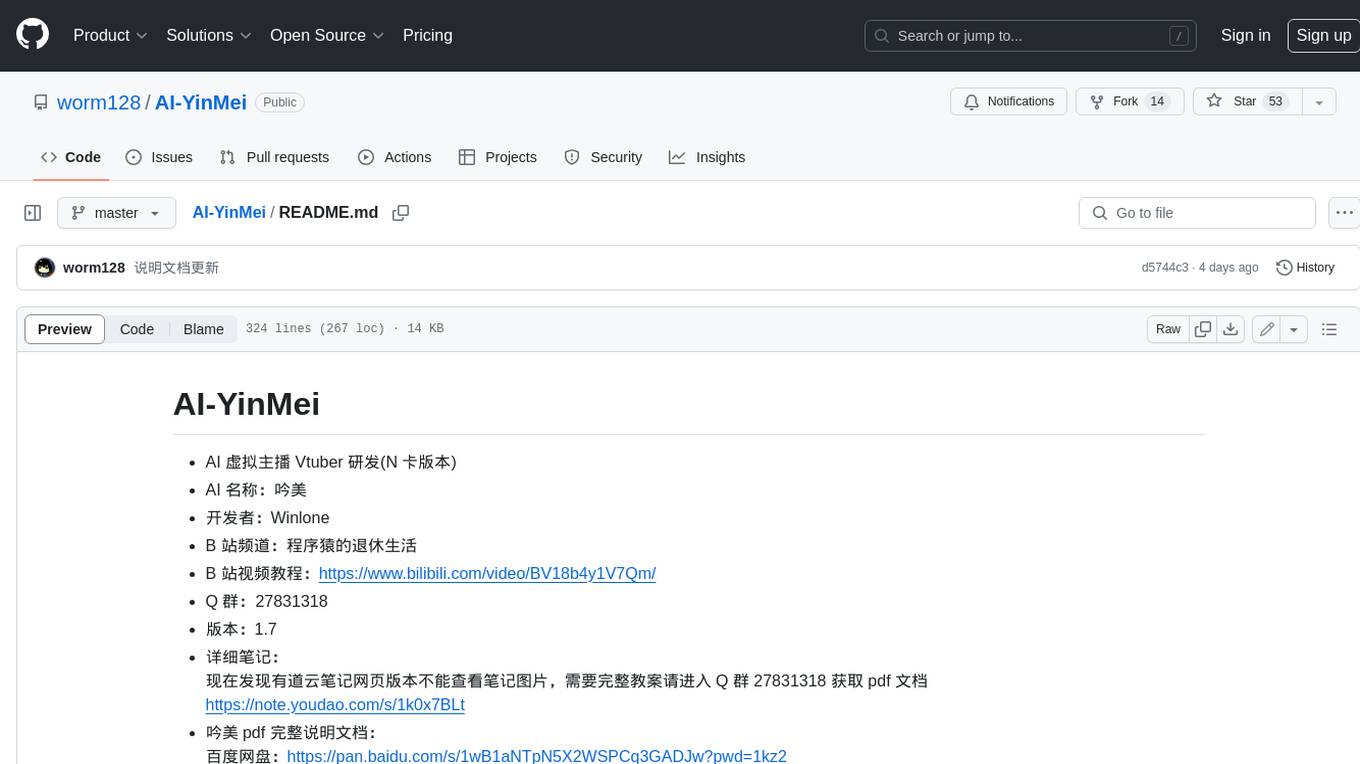
AI-YinMei
AI-YinMei is an AI virtual anchor Vtuber development tool (N card version). It supports fastgpt knowledge base chat dialogue, a complete set of solutions for LLM large language models: [fastgpt] + [one-api] + [Xinference], supports docking bilibili live broadcast barrage reply and entering live broadcast welcome speech, supports Microsoft edge-tts speech synthesis, supports Bert-VITS2 speech synthesis, supports GPT-SoVITS speech synthesis, supports expression control Vtuber Studio, supports painting stable-diffusion-webui output OBS live broadcast room, supports painting picture pornography public-NSFW-y-distinguish, supports search and image search service duckduckgo (requires magic Internet access), supports image search service Baidu image search (no magic Internet access), supports AI reply chat box [html plug-in], supports AI singing Auto-Convert-Music, supports playlist [html plug-in], supports dancing function, supports expression video playback, supports head touching action, supports gift smashing action, supports singing automatic start dancing function, chat and singing automatic cycle swing action, supports multi scene switching, background music switching, day and night automatic switching scene, supports open singing and painting, let AI automatically judge the content.






